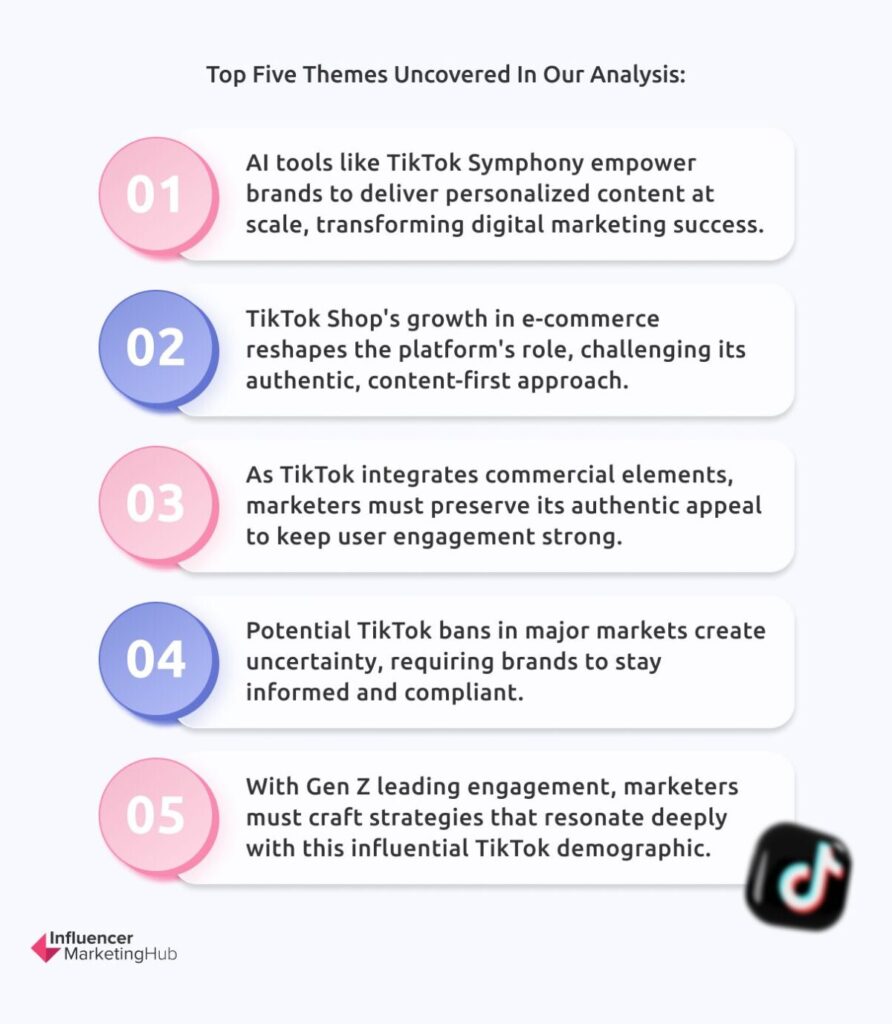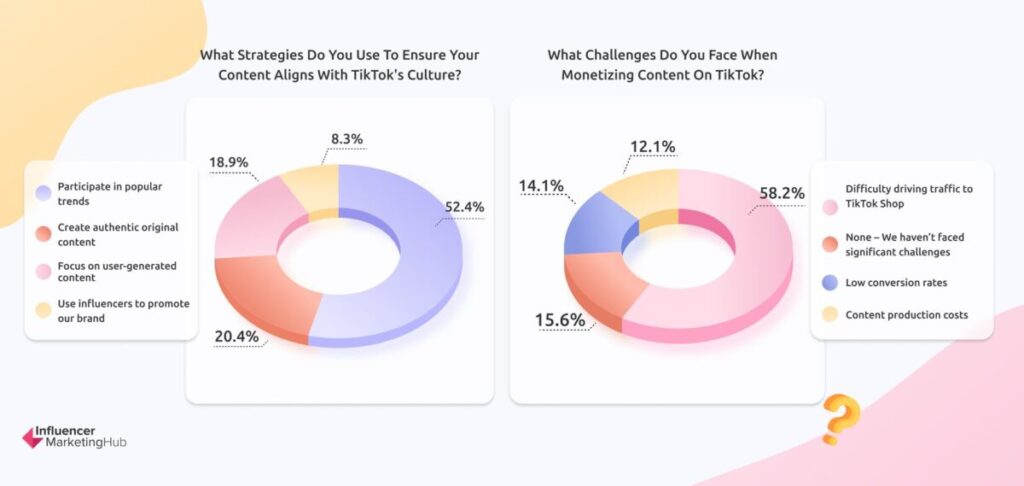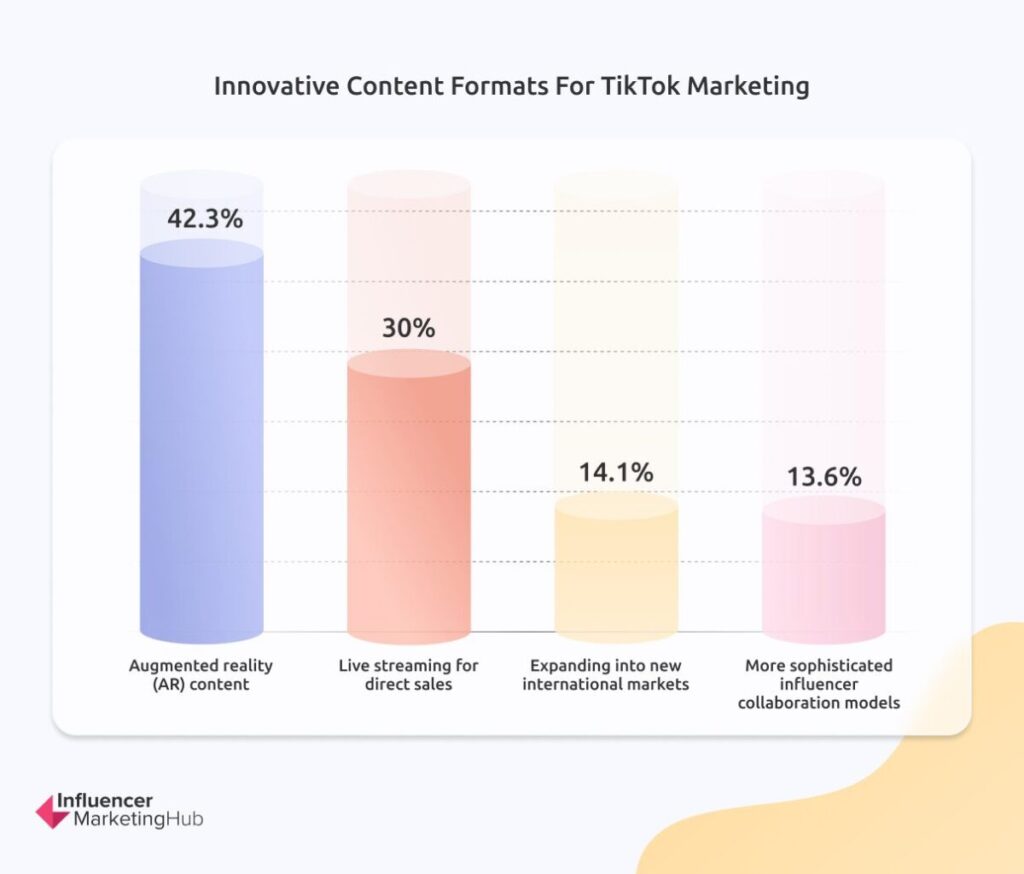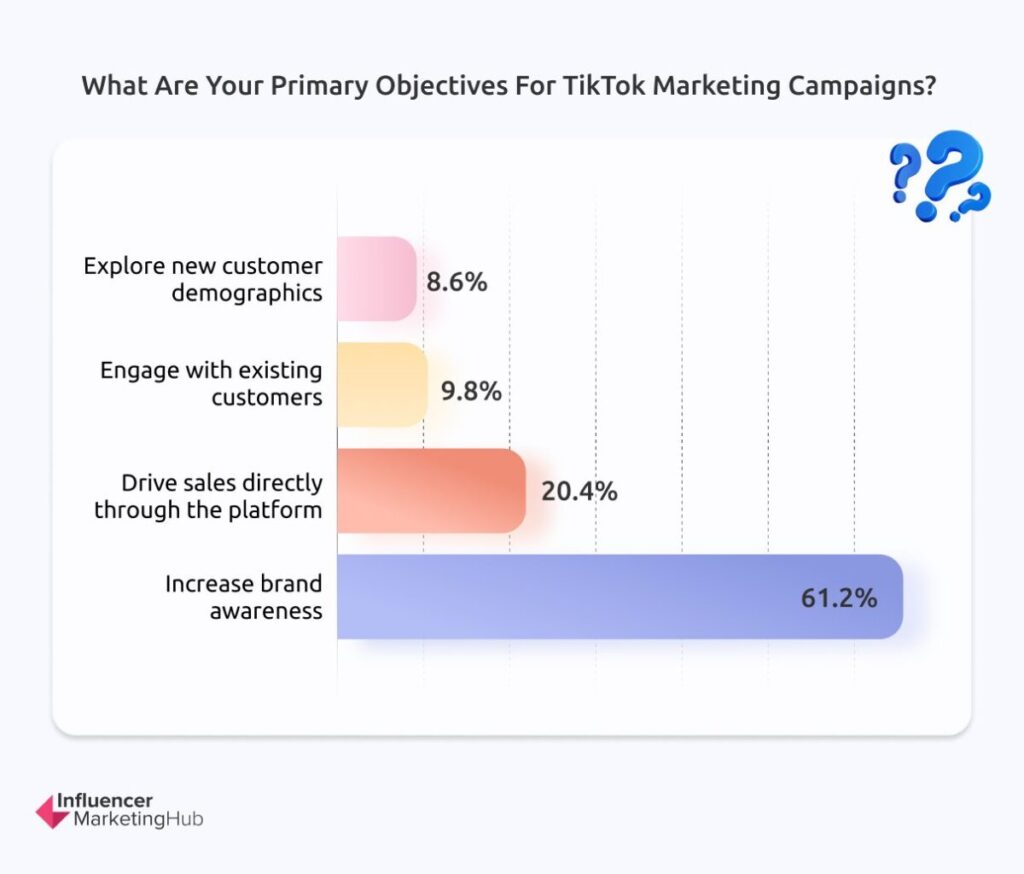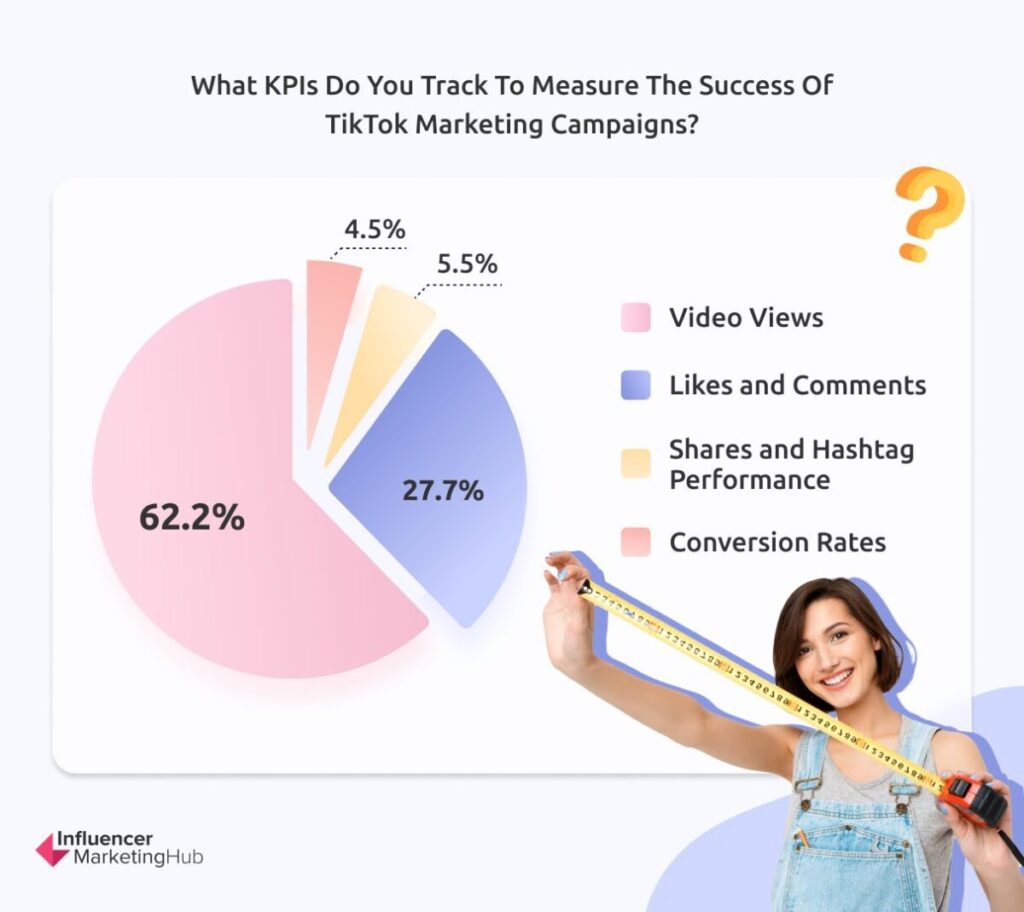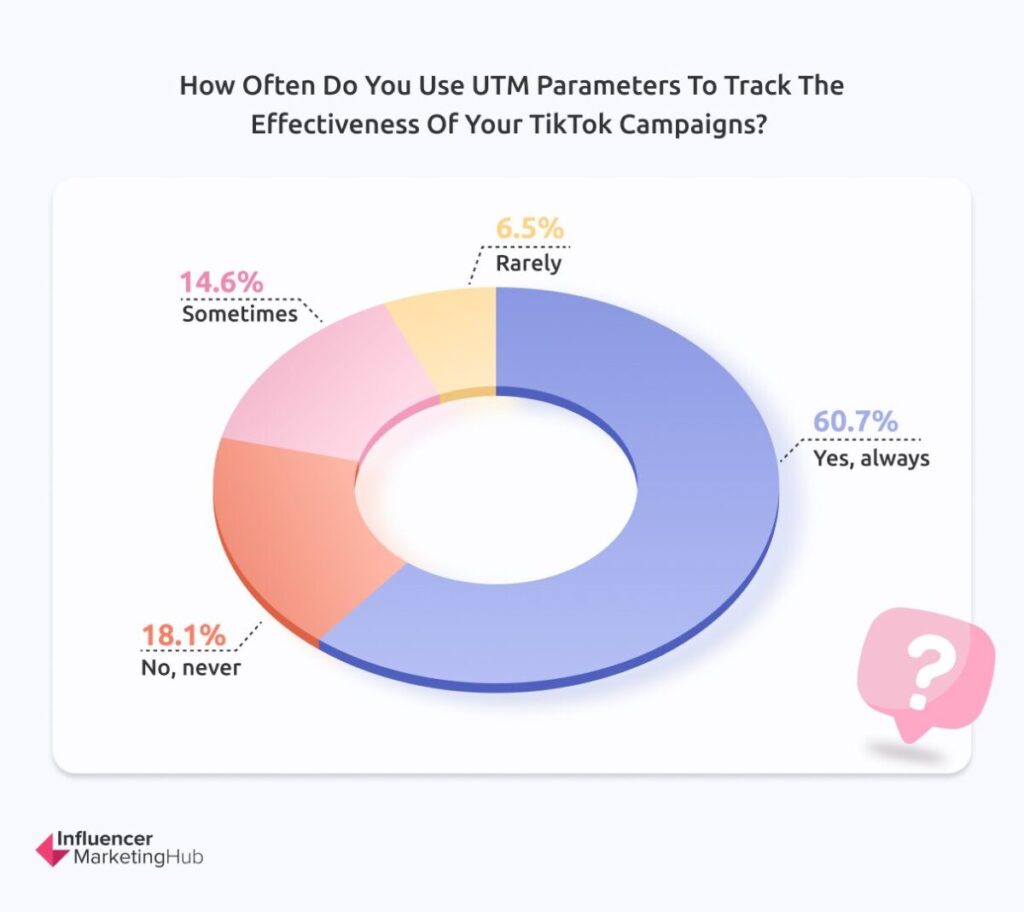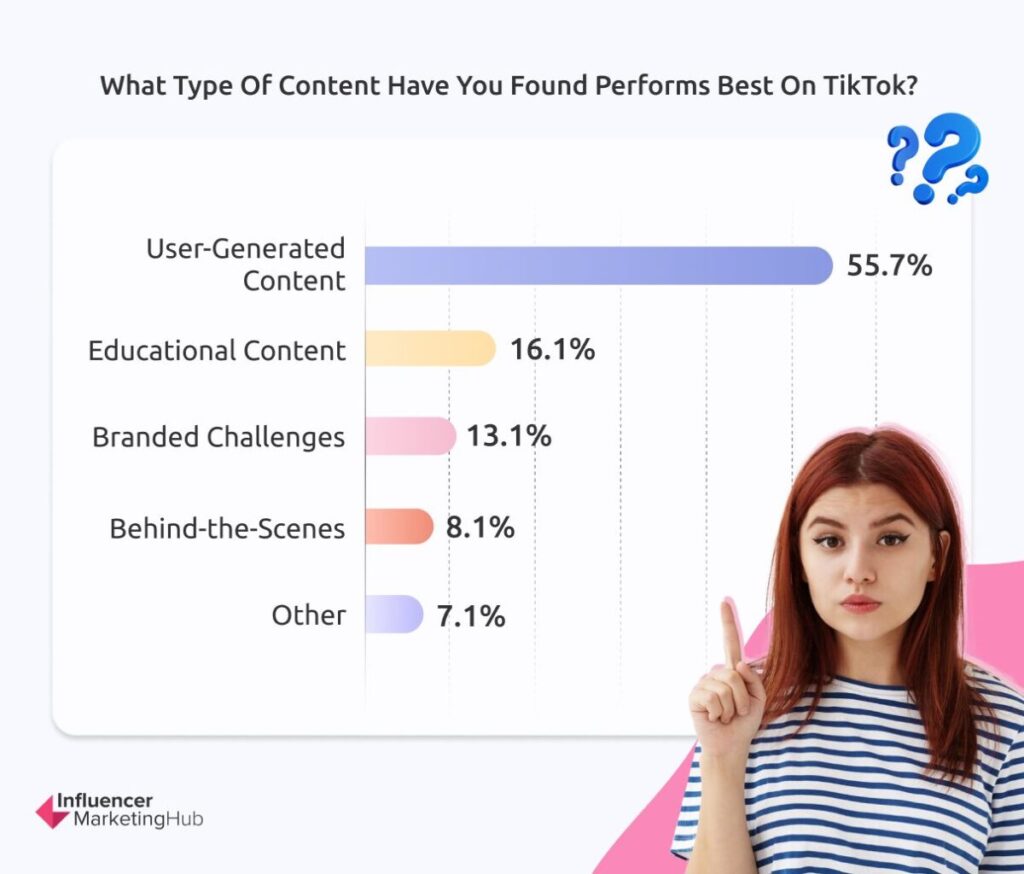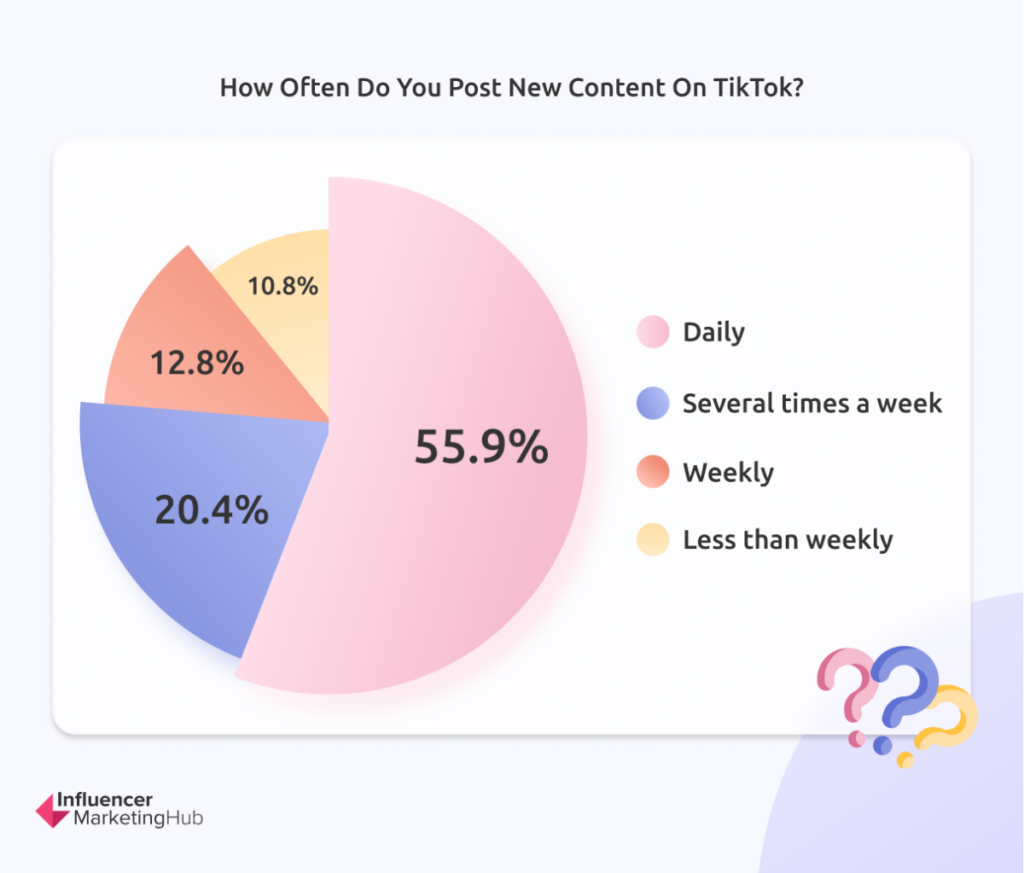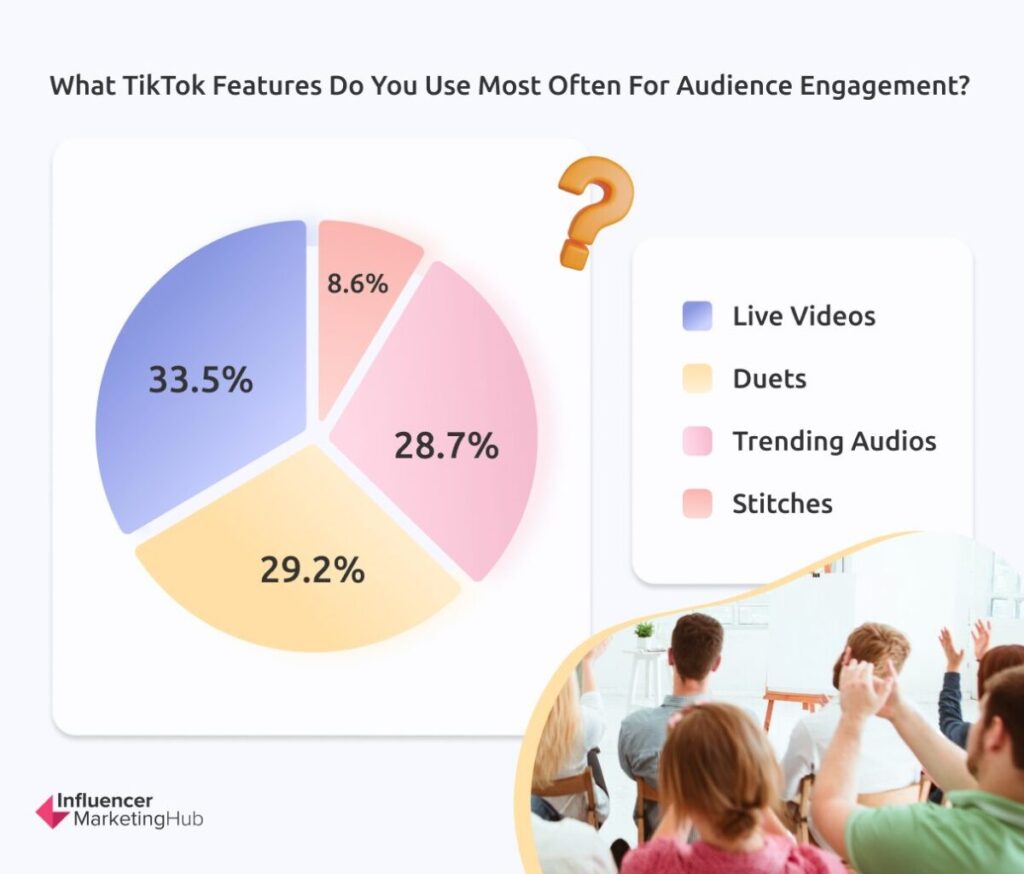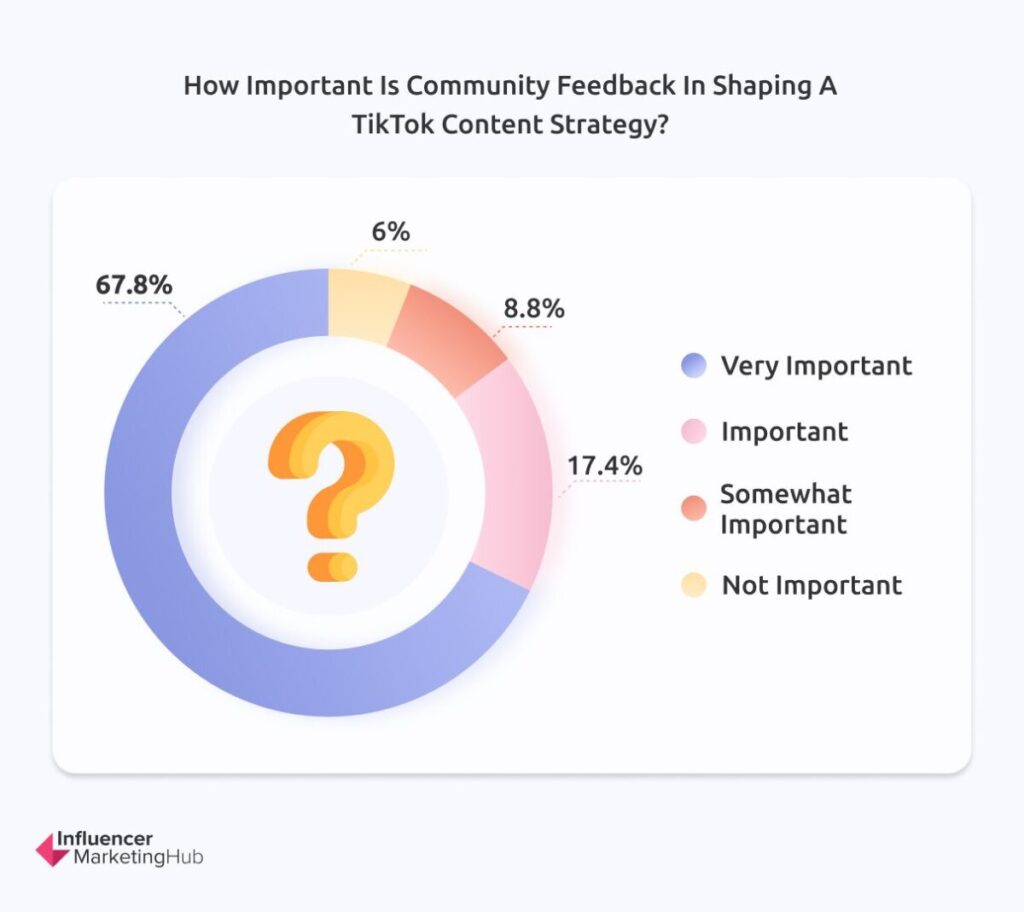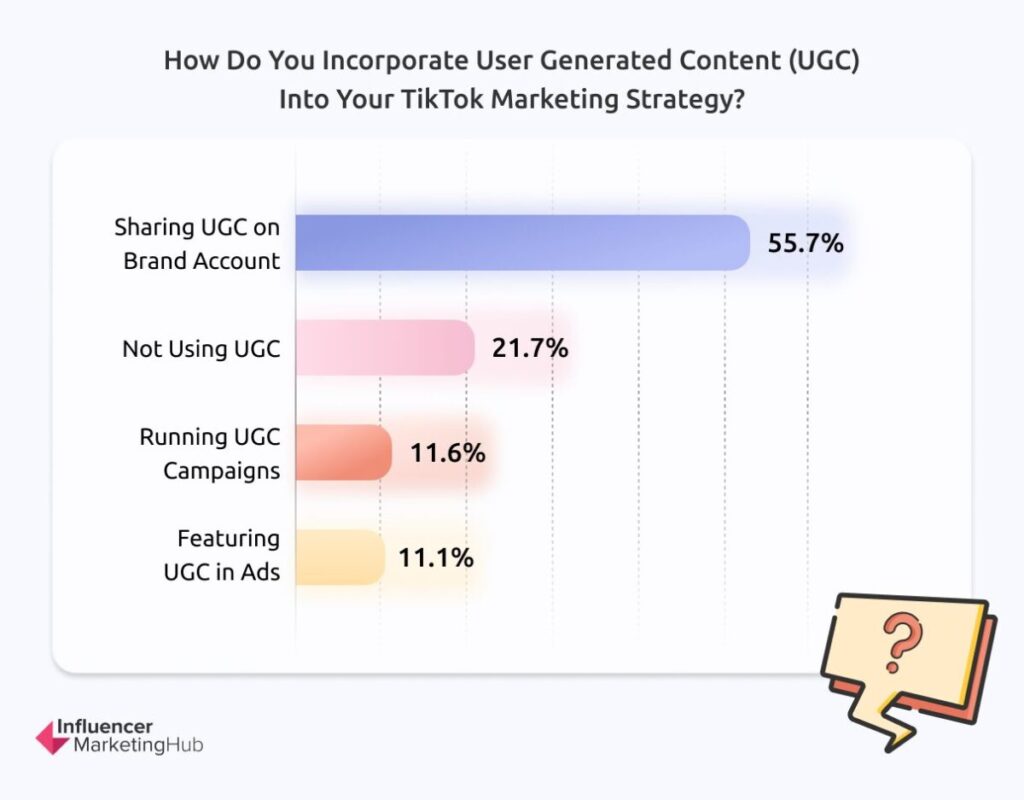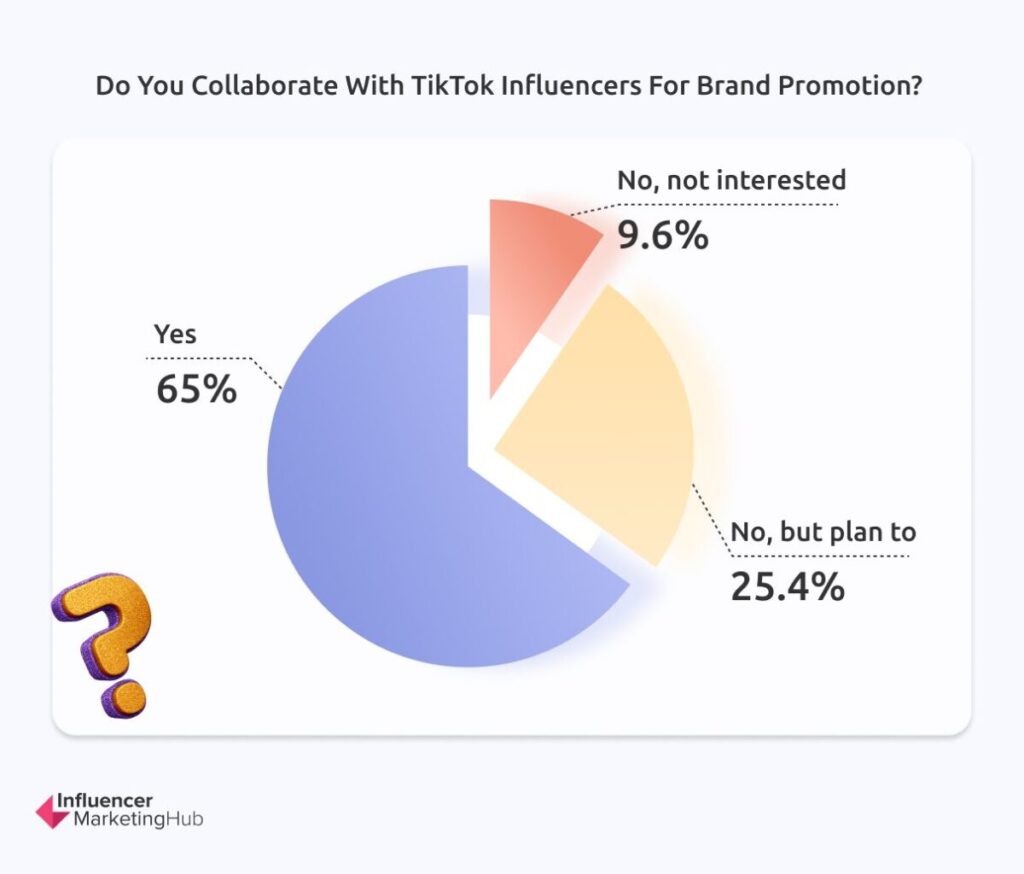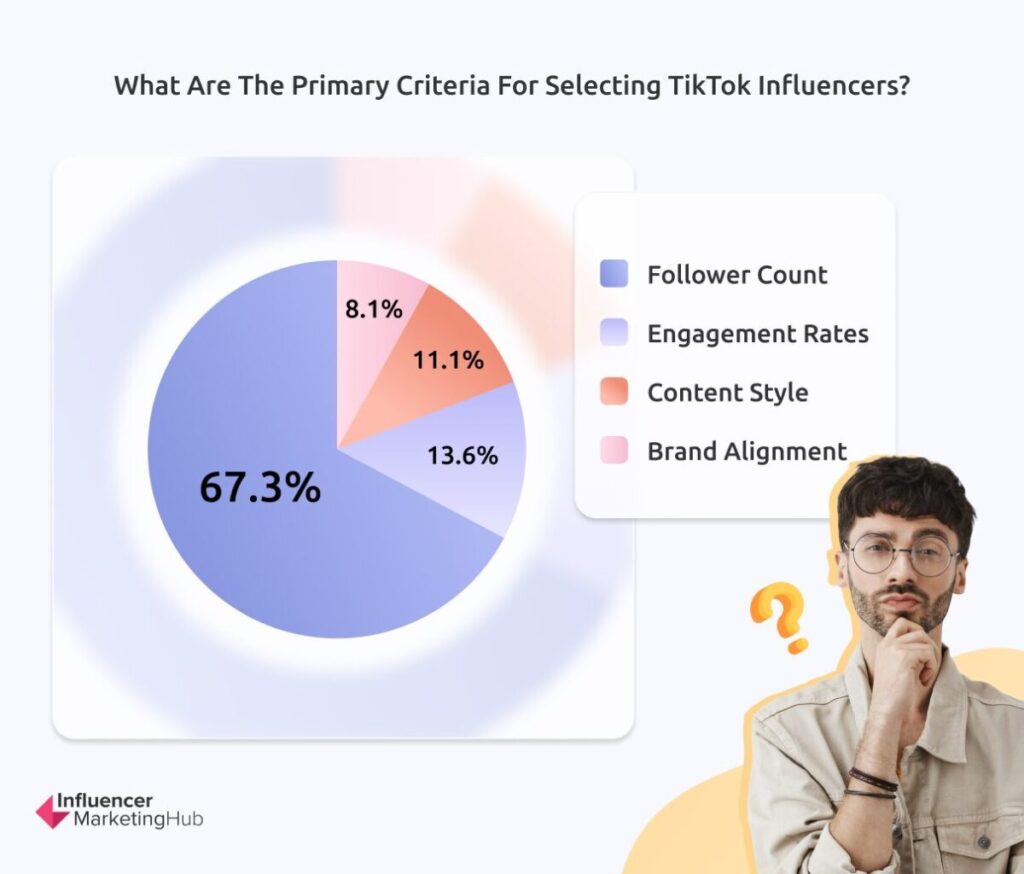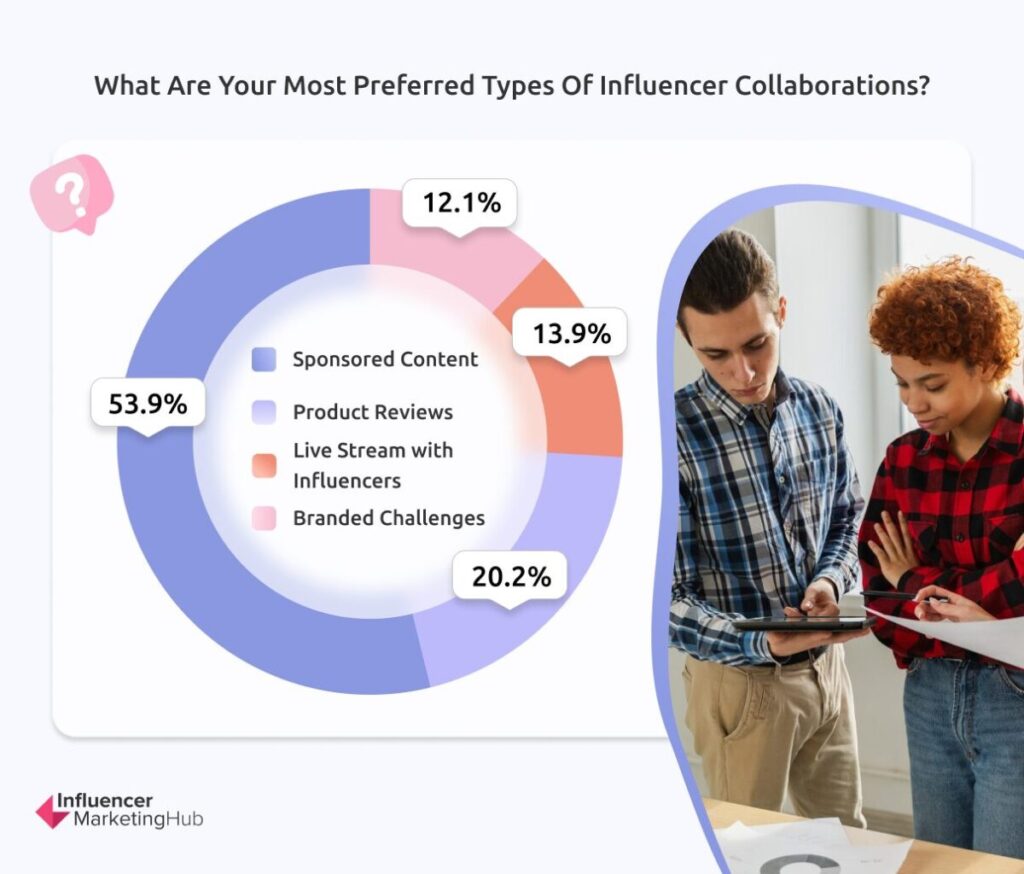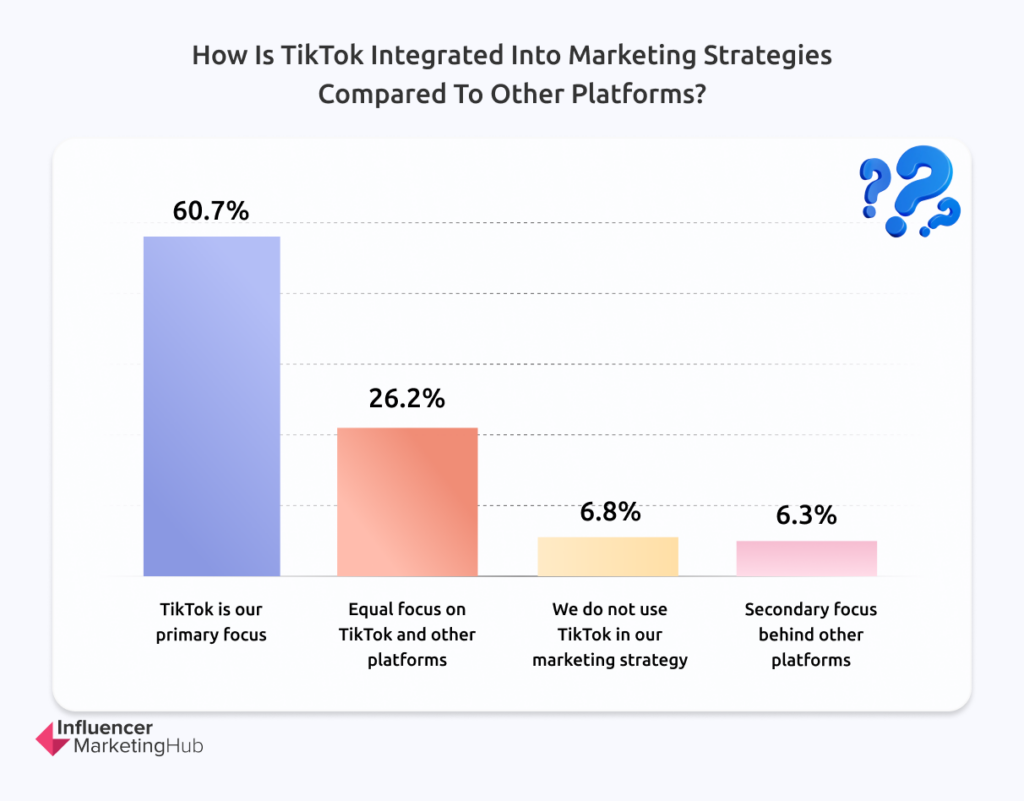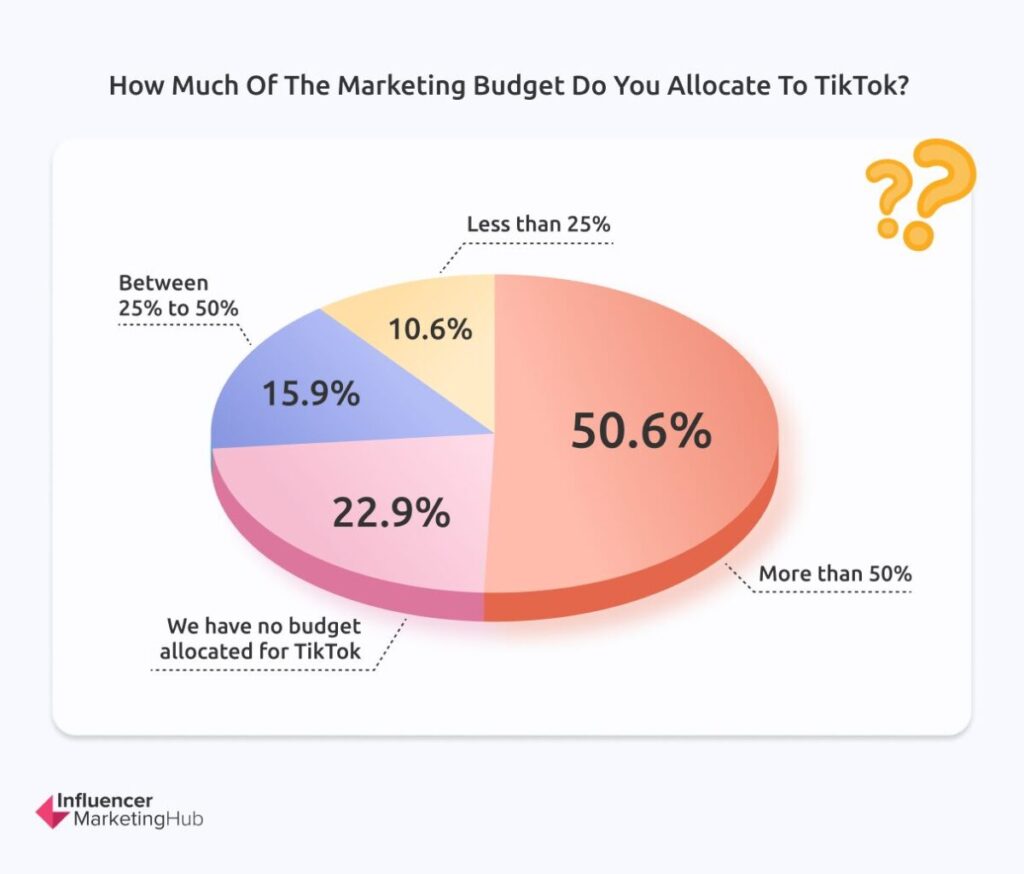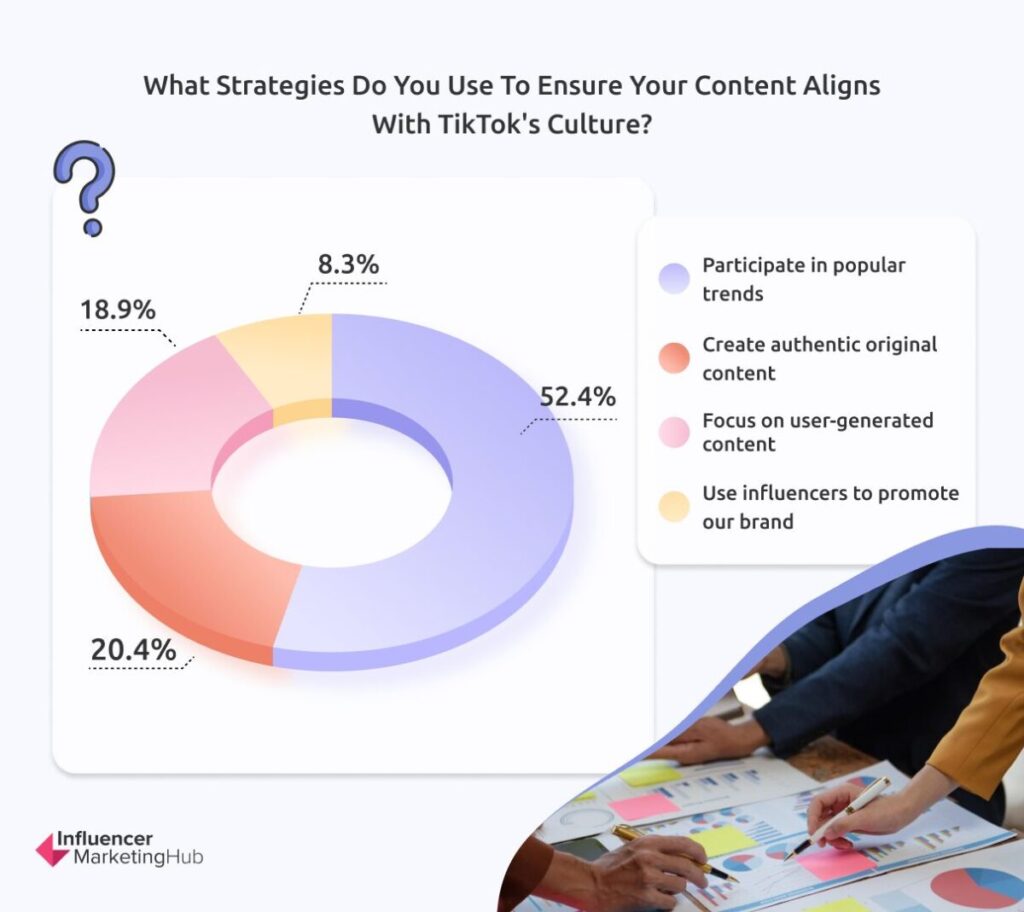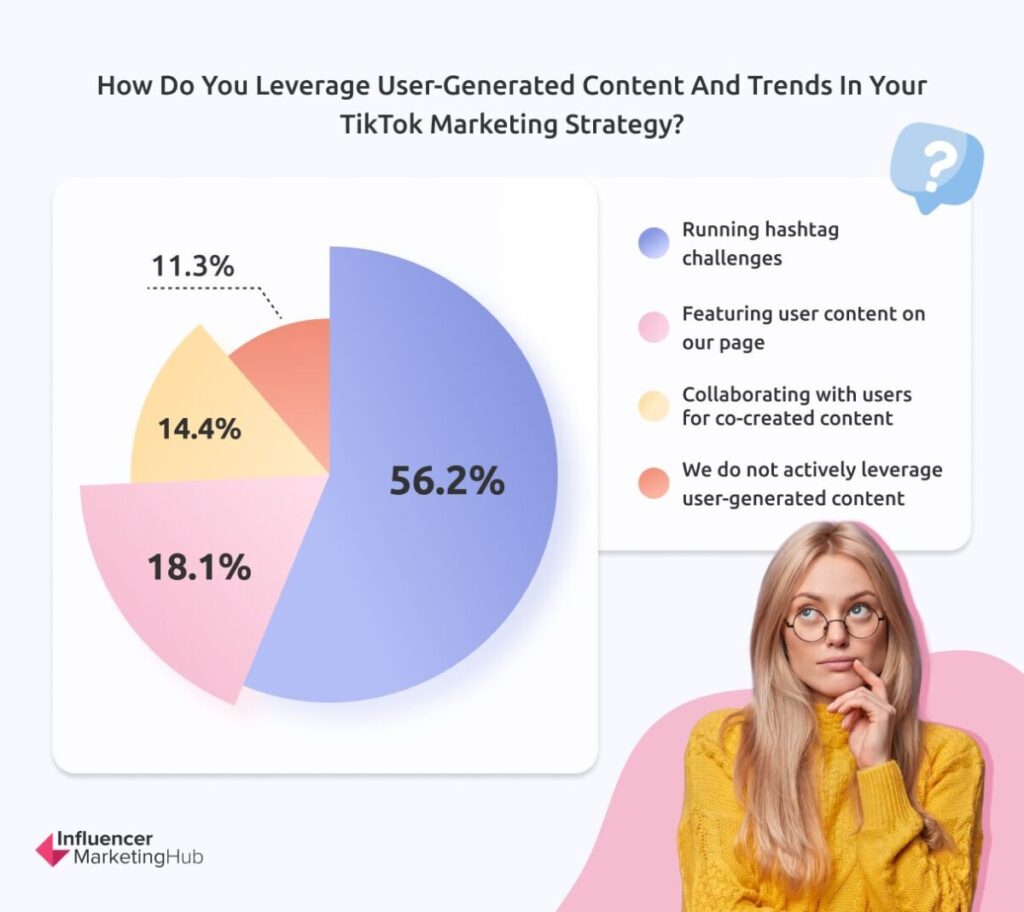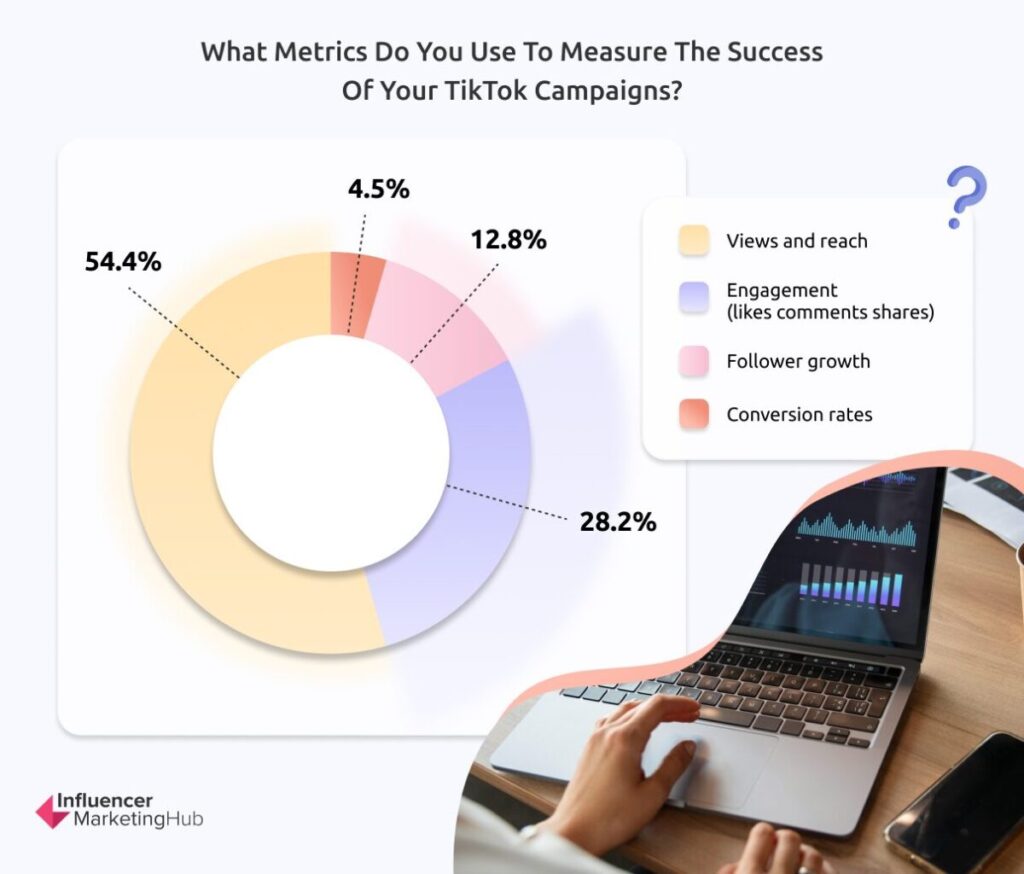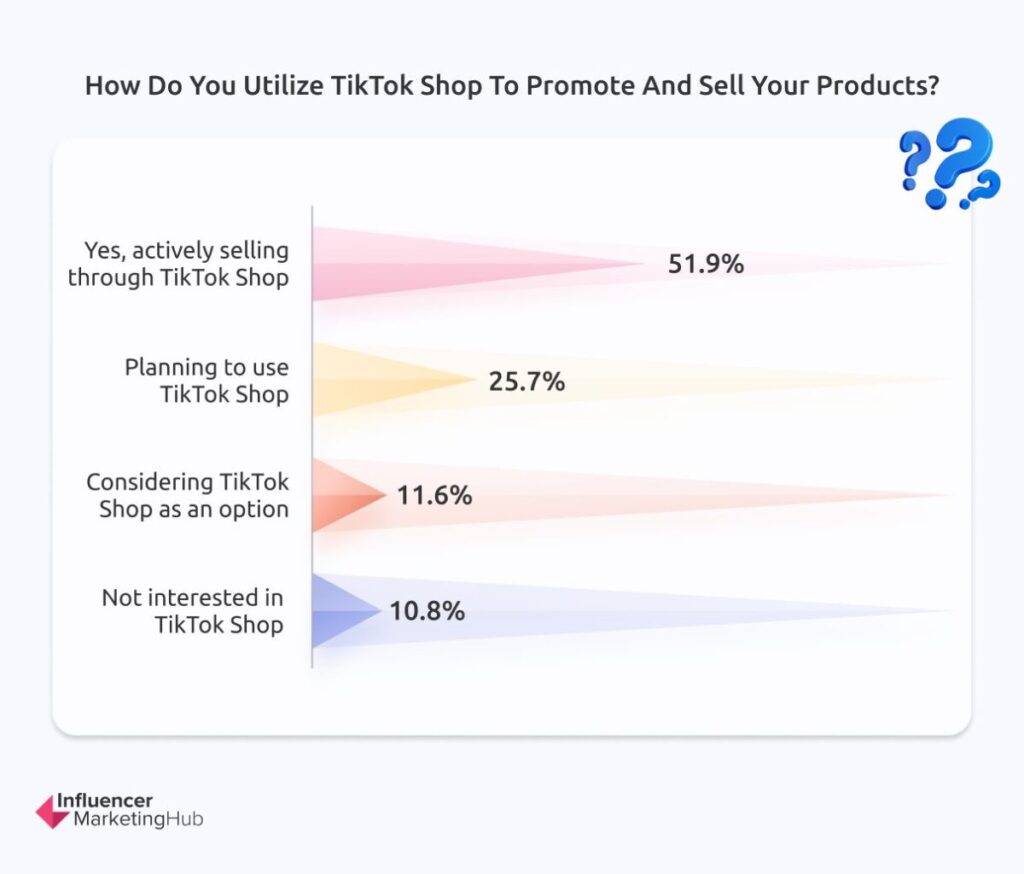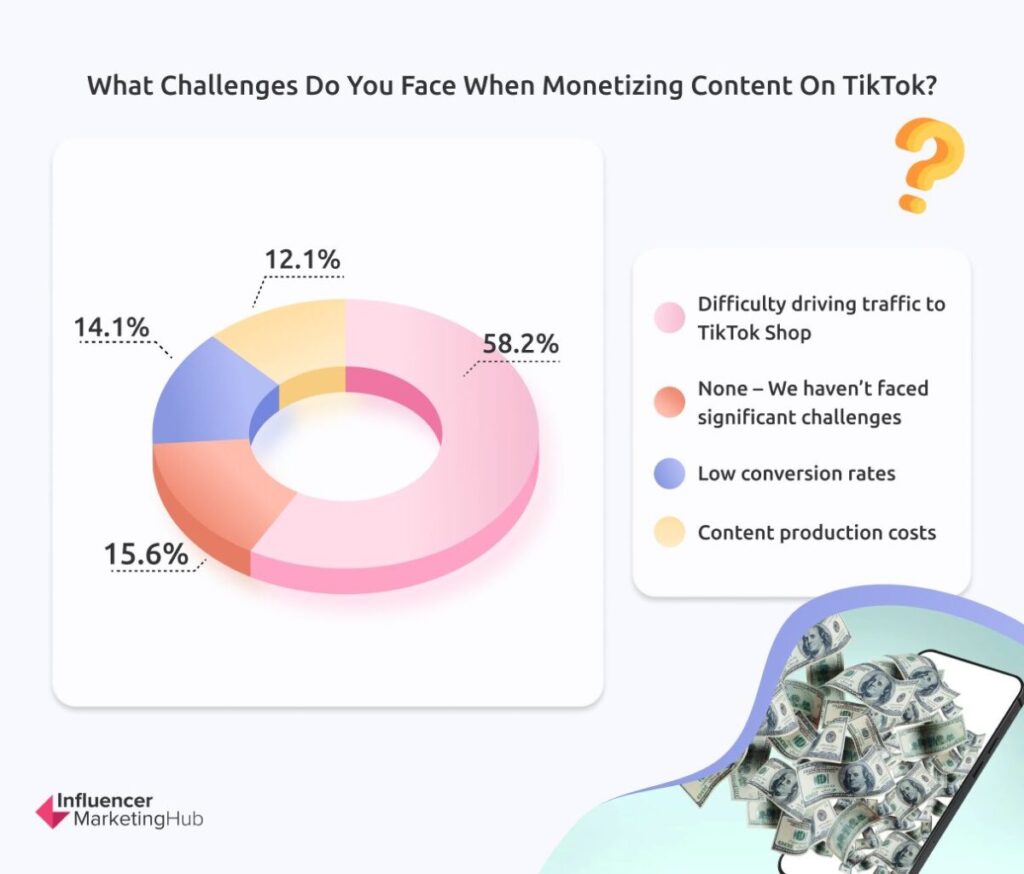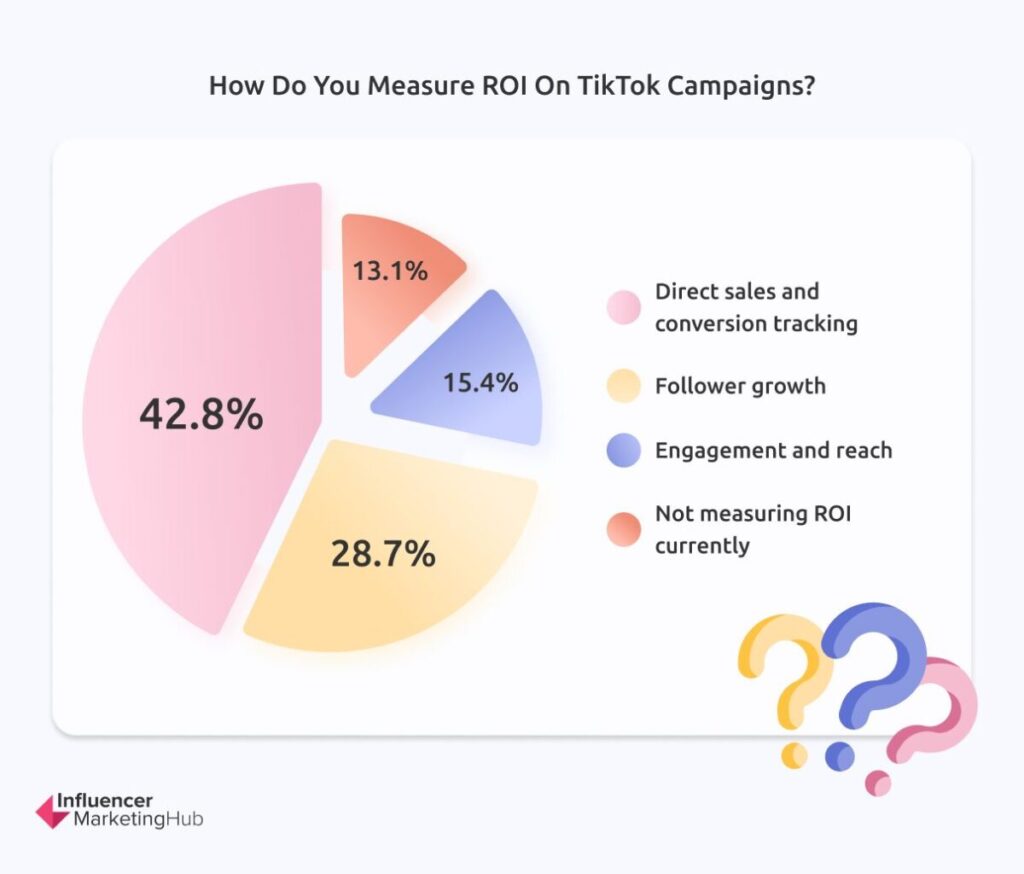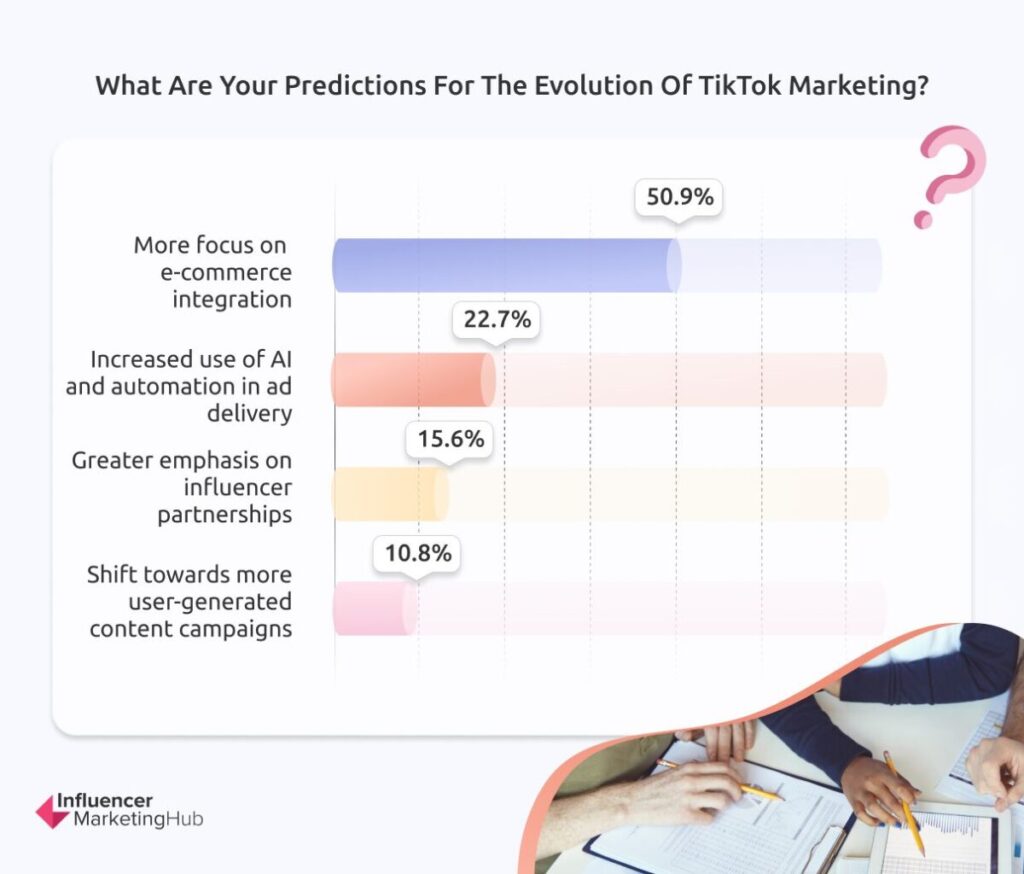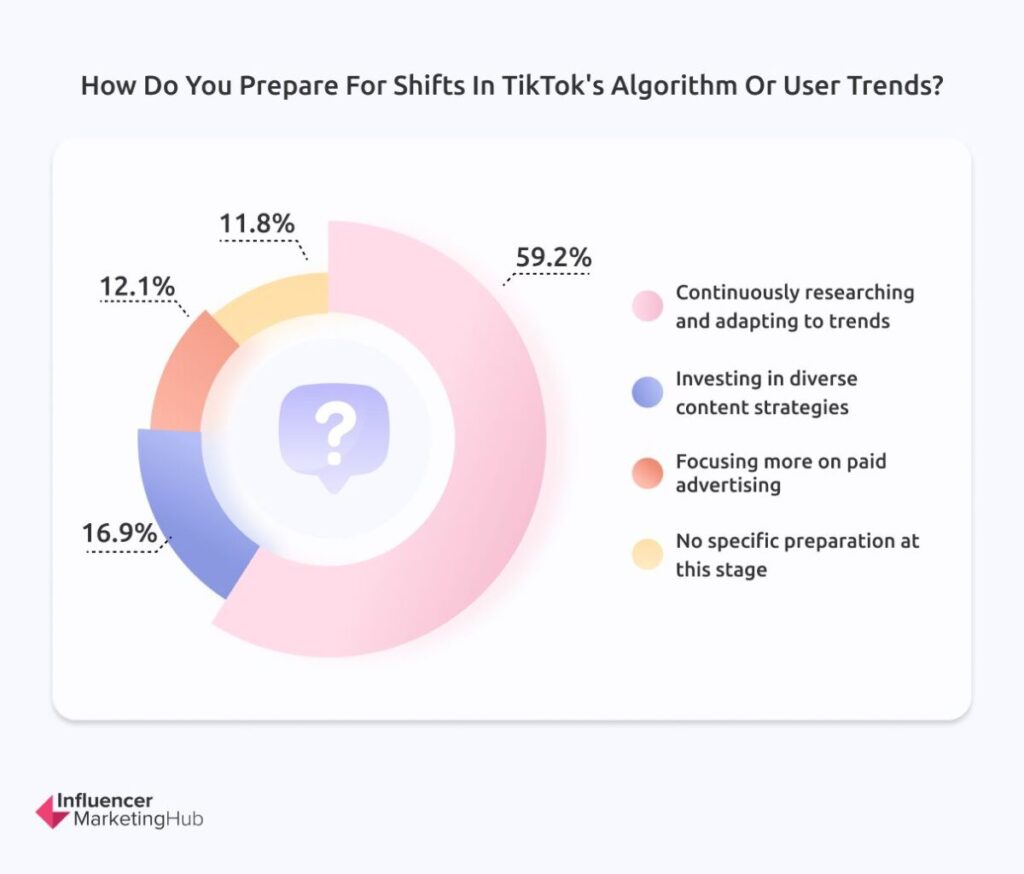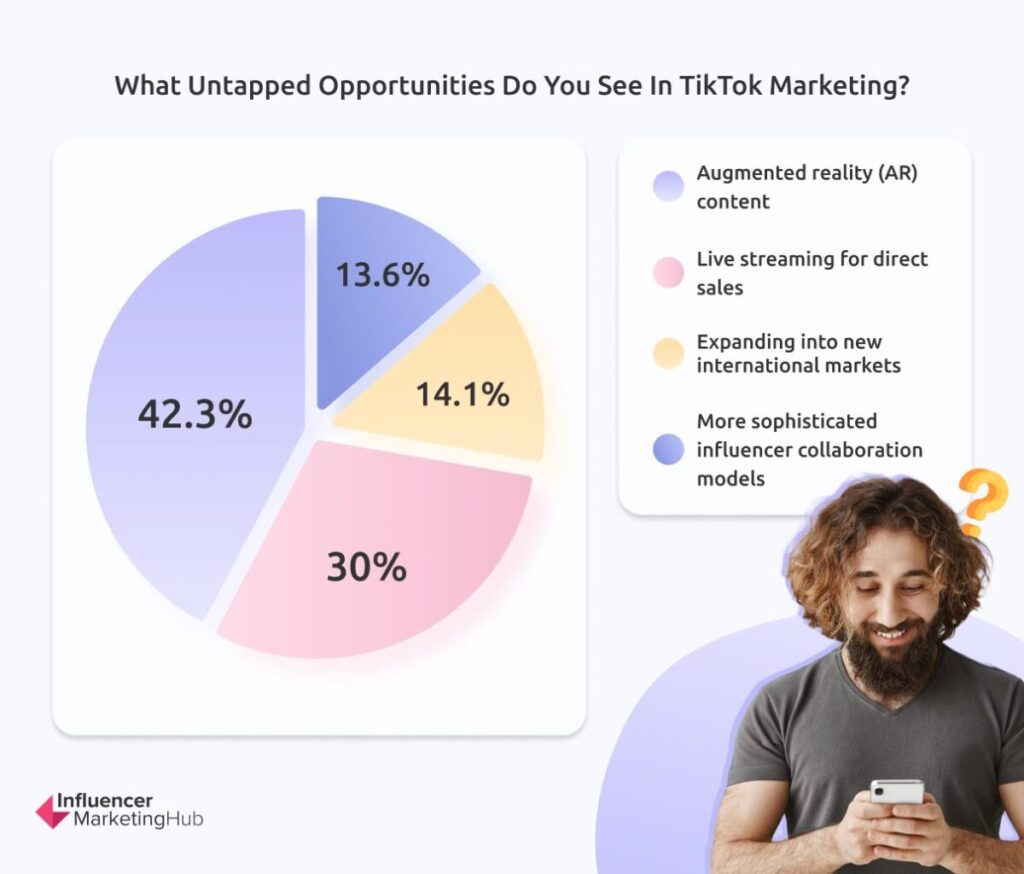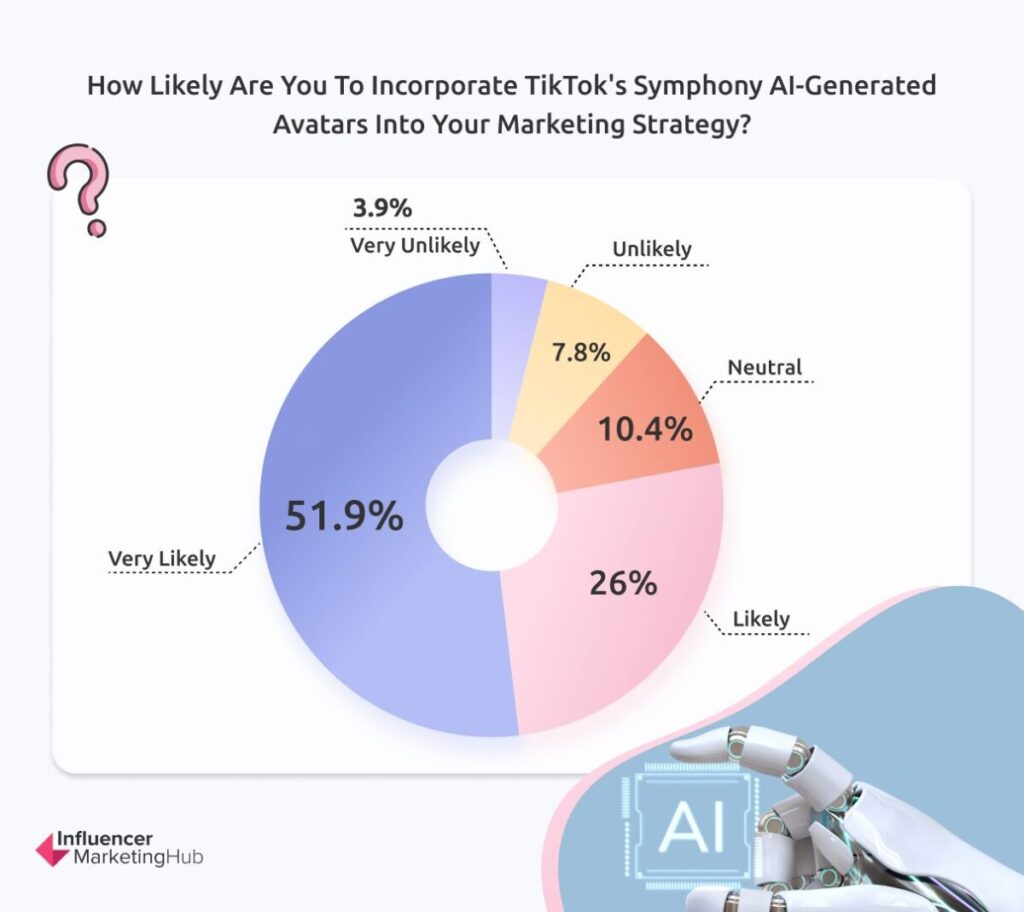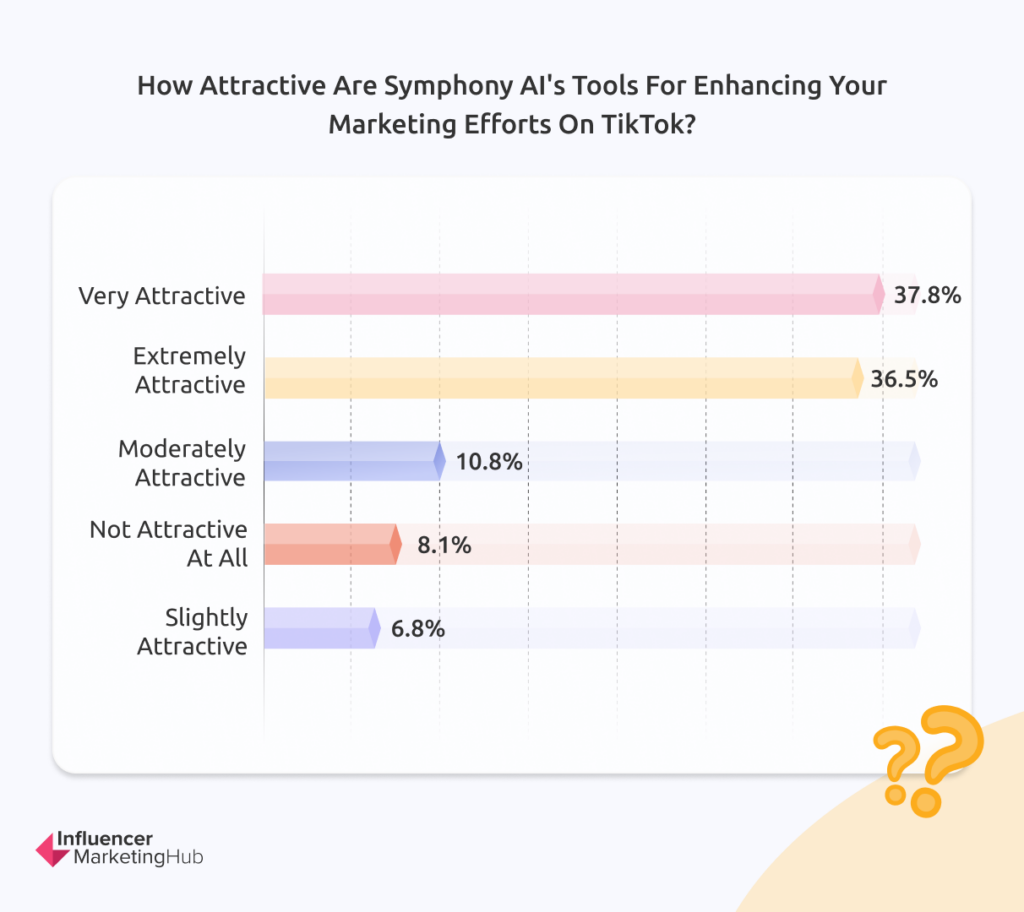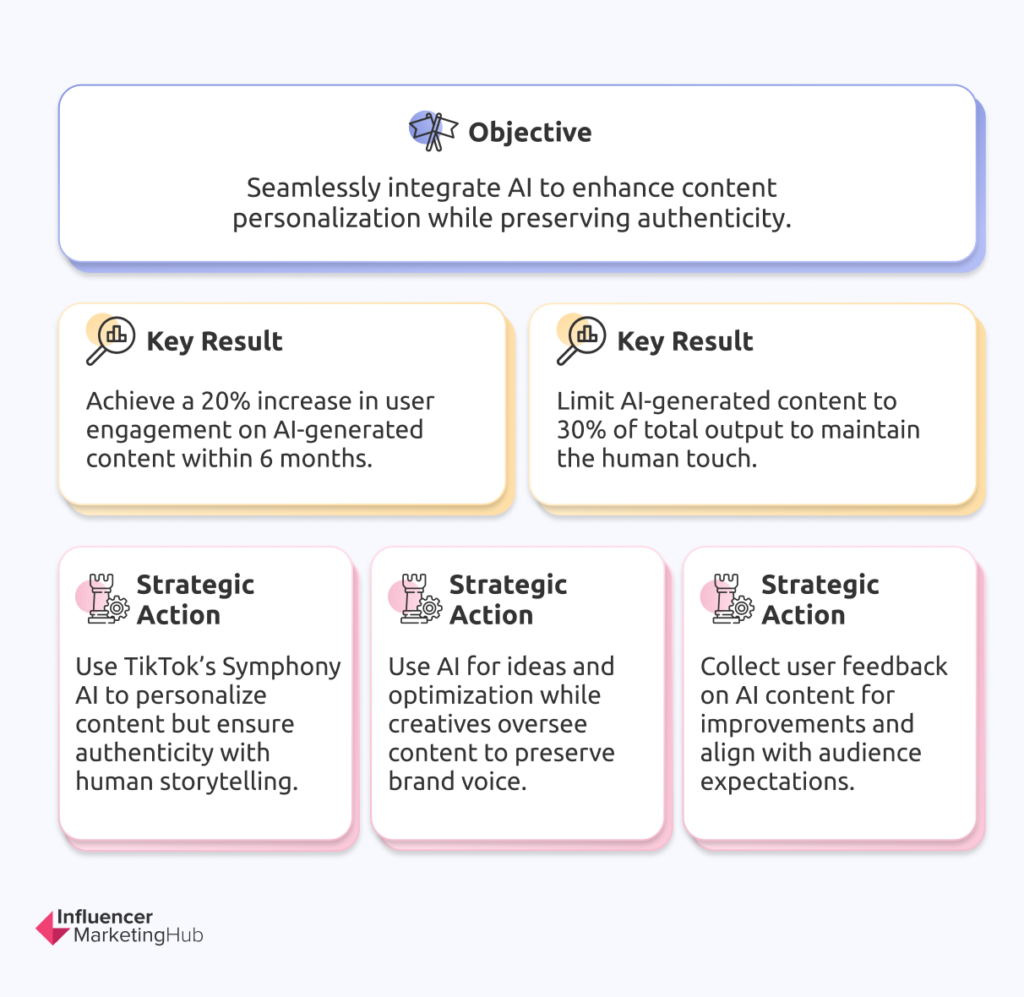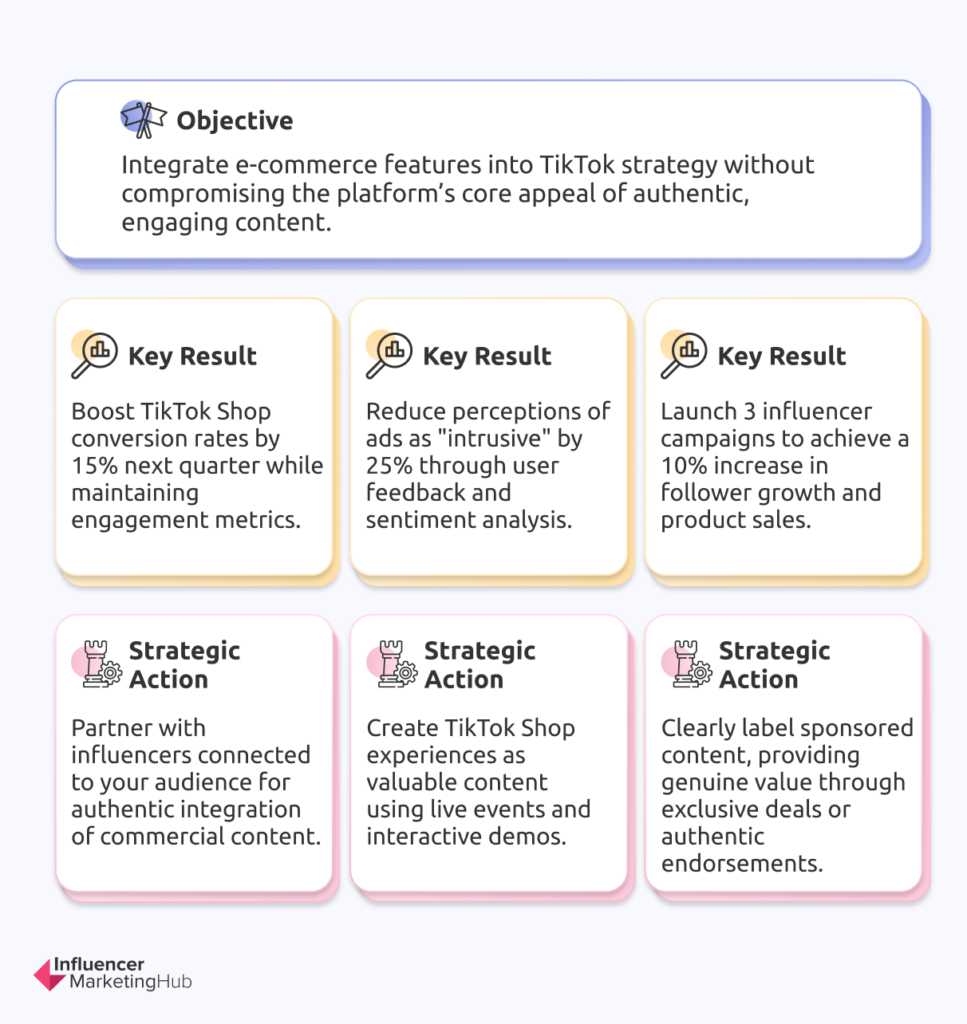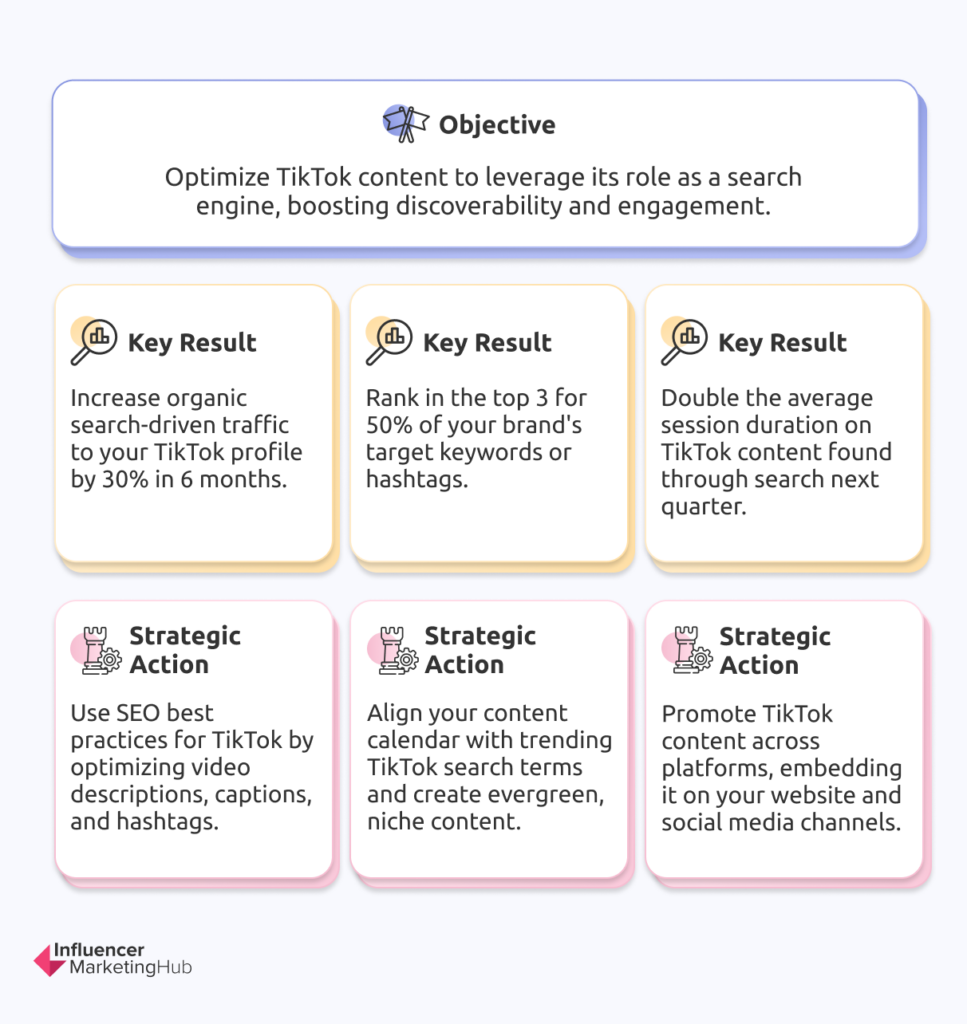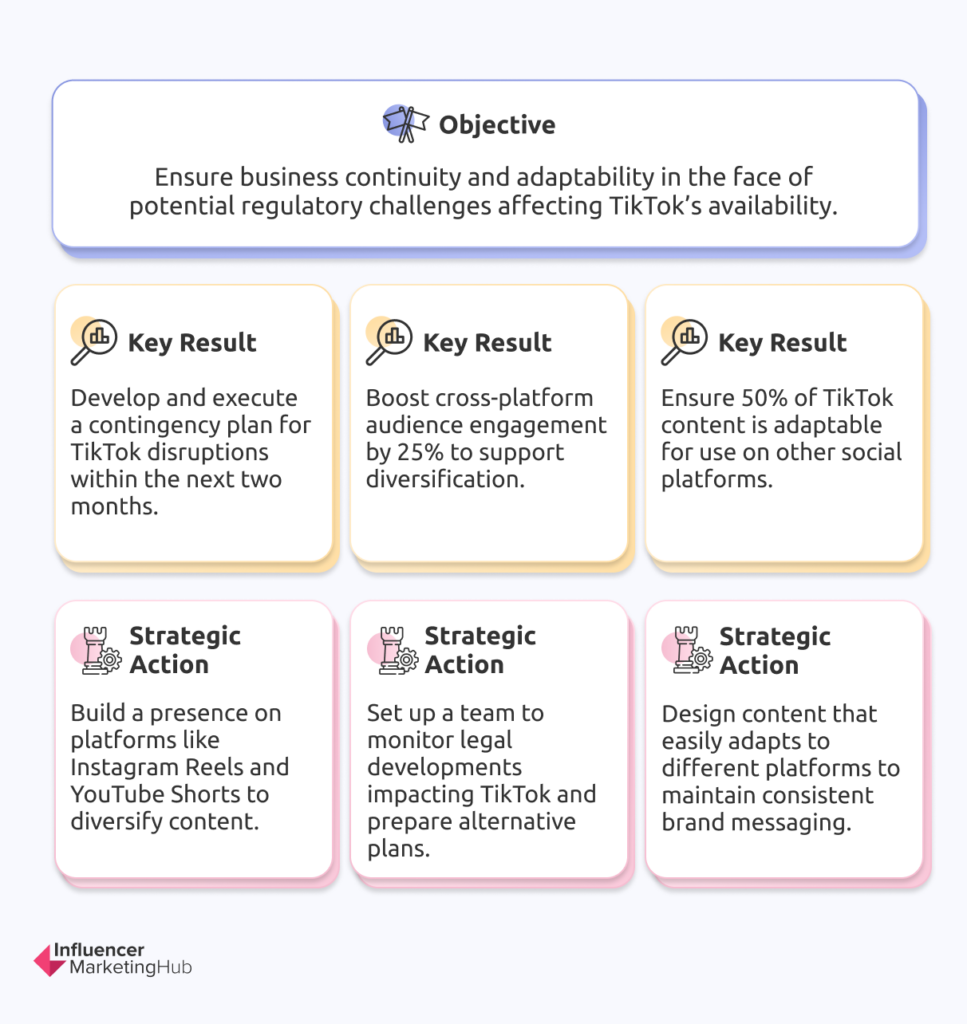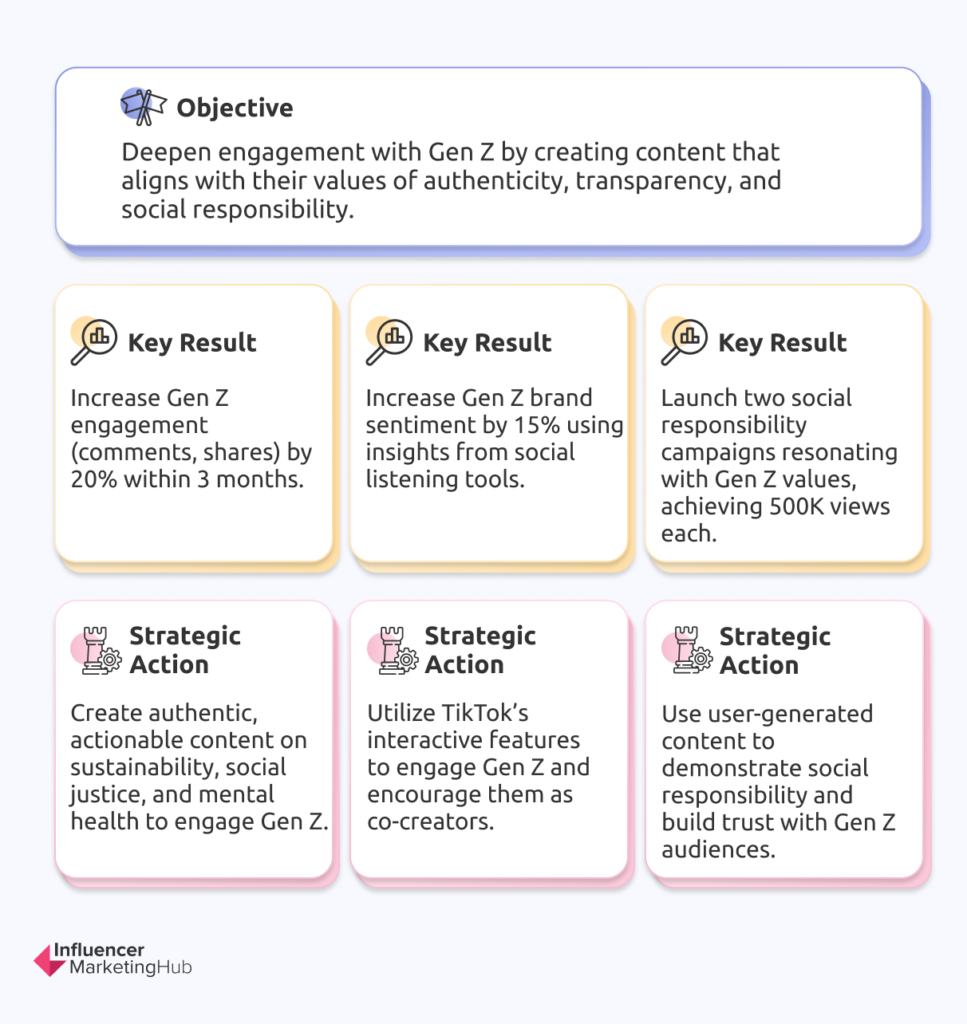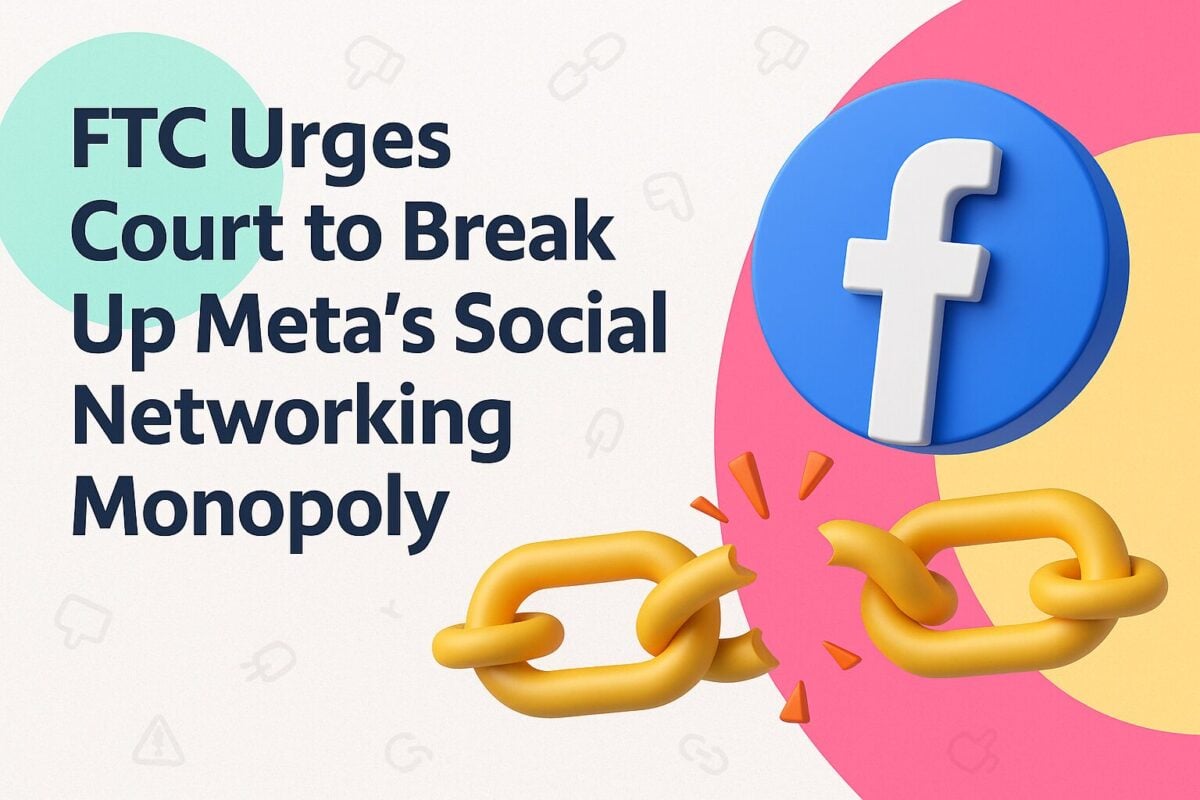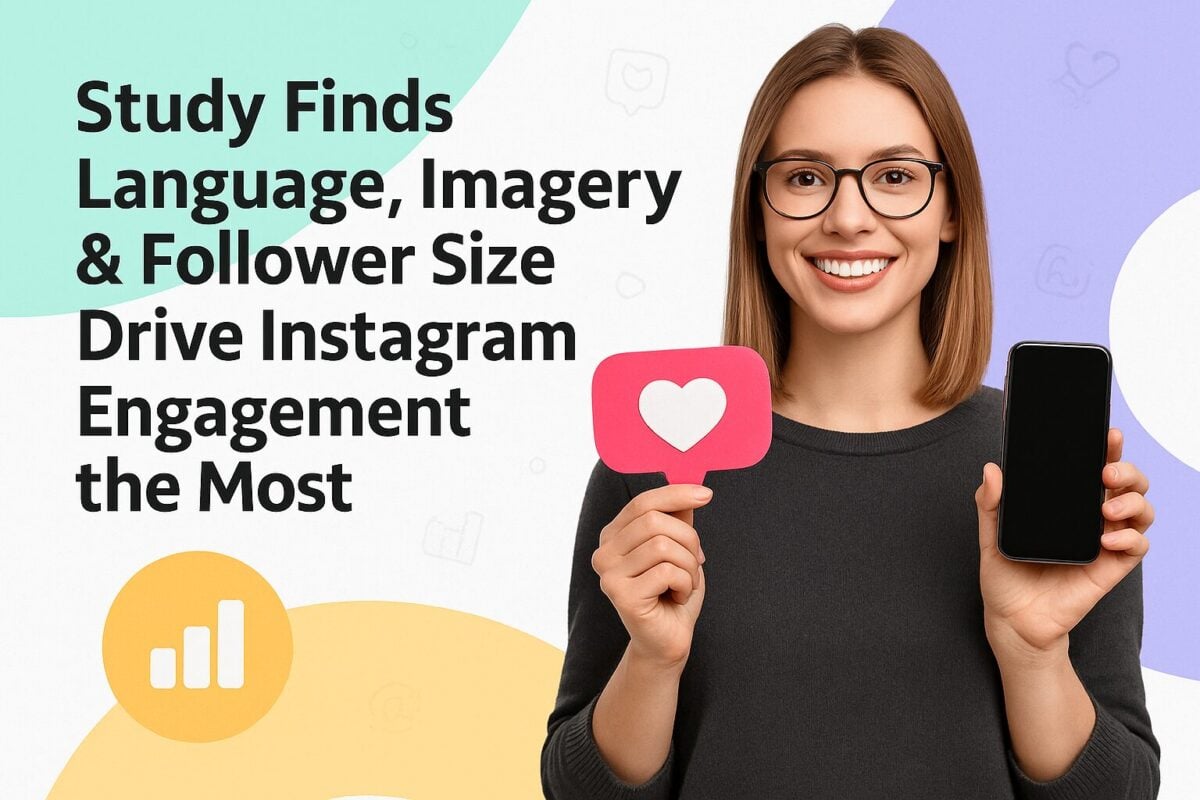Consider this striking statistic: 71% of TikTok users decide whether to continue watching a video within the first three seconds. This underscores the rapid pace and fiercely competitive nature of digital content consumption, where a fleeting moment can make or break a campaign.
TikTok has emerged as a titan in the social media space, boasting over 1.6 billion active users and an unparalleled engagement rate. Every day, millions of videos are uploaded, creating a deluge of content that vies for users’ fleeting attention. Marketers face a tough digital landscape, fighting to be seen and resonate. According to our survey, 61.2% of marketers focus on brand awareness as their primary objective. Therefore, the challenge is to create content that captures attention instantly and resonates deeply to convert interest into meaningful engagement.
Key Marketing TikTok Statistics - Short Version
To uncover the driving trends in TikTok marketing and social selling, we gathered data from 397 marketers on Influencer Marketing Hub. Here are the critical insights shaping the future of digital engagement:
Rising AI Integration in TikTok Marketing:
- 51.9% are very likely to incorporate AI-generated avatars into their campaigns.
- 74.3% of marketers find Symphony AI’s tools highly attractive.
Key Performance Indicators (KPIs) to Measure TikTok Success:
- Video views (62.2%) and likes/comments (27.7%) are critical indicators of success.
- Shares and hashtag performance (5.5%) and conversion rates (4.5%) also play a role.
Best Performing Content Types on TikTok:
- User-generated content leads at 55.7%.
- Educational content (16.1%) and branded challenges (13.1%) follow closely.
Utilization of TikTok Shop for Products:
- 51.9% are actively selling through TikTok Shop.
- 25.7% are planning to use TikTok Shop soon.
Emphasis on Community Feedback:
- 67.8% of marketers consider community feedback very important in shaping their content strategy.
- Key Marketing TikTok Statistics - Short Version
- Editorial Team Notes
- TikTok Marketing Technology & Features in 2024
- TikTok Marketing Challenges in 2024
- TikTok Opportunities and Trends in 2024
- TikTok Marketing Stats 2024 - behavior, features, technology and much more
- The Future of TikTok Marketing
- Strategic Recommendations: What Marketers Must Do Now
- Methodology and Data Transparency
Editorial Team Notes
We find ourselves at a pivotal moment in the evolution of TikTok, a platform that continues to captivate global audiences with its unique blend of creativity, authenticity, and rapid innovation. As TikTok enters a new era, the opportunities and challenges it presents to marketers are both exciting and transformative.
TikTok leverages mimetic desire, where people imitate the desires of others, particularly among Gen Z users. AI integration in marketing strategies on TikTok amplifies this potential. Tools like TikTok Symphony offer efficiency and personalization, and if TikTok influencers manage to master the tool, while TikTok improve their AI in the features, combined with the opportunities in the TikTok Shop accounts, marketers might be looking at moving more significant budgets towards TikTok Advertising Spend.
Here are the five themes that emerged from our analysis:
- AI-Powered Personalization is Revolutionizing TikTok Marketing: With tools like TikTok Symphony, AI is no longer a supplementary tool but a central driver of marketing success, enabling brands to create highly personalized and engaging content at scale.
- E-commerce Integration is Reshaping TikTok’s Identity: The introduction and rapid adoption of TikTok Shop are transforming the platform into a significant player in social commerce, although it challenges the platform’s authentic content-first appeal.
- Navigating the Balance Between Authenticity and Commercialization: As TikTok integrates more commercial elements, the challenge for marketers lies in maintaining the platform’s core appeal of authentic, engaging content without alienating users.
- Regulatory Uncertainty and the Looming TikTok Ban: The potential for a TikTok ban in major markets like the U.S. introduces significant uncertainty for brands that heavily rely on the platform, making it crucial to stay informed and agile.
- Gen Z’s Dominance and Engagement: With Gen Z users showing strong attachment to TikTok, marketers need to focus on strategies that resonate deeply with this demographic, as they are the most influential group on the platform.
In this context, TikTok’s introduction of TikTok Shop, a feature that integrates e-commerce into the platform, adds a commercial layer that challenges the platform’s core appeal of authentic and engaging content. With 51.9% of marketers actively selling through TikTok Shop, it’s clear that this new feature is being embraced for its potential to drive direct sales and streamline the shopping experience.
In this report, we delve into the current trends, opportunities, and challenges facing marketers on TikTok. We explore successful strategies, backed by comprehensive survey data, and offer a forward-looking perspective on thriving in this dynamic environment. Join us as we uncover the future of marketing in the age of TikTok, where every second counts, and the human touch makes all the difference.
TikTok Marketing Technology & Features in 2024
Gen Z values authenticity, immediacy, and personalization—qualities that TikTok Symphony and TikTok Shop provide in abundance. AI-generated avatars offer a blend of human touch and technological efficiency, creating content that is both engaging and relatable. Meanwhile, TikTok Shop caters to Gen Z’s preference for seamless, integrated shopping experiences, turning social interactions into instant commercial opportunities.
By introducing these features, TikTok not only enhances its platform’s functionality but also deepens its connection with its core audience. The synergy between these innovations and the preferences of Gen Z users ensures that TikTok remains at the forefront of social media evolution, continually offering fresh and engaging ways for brands to connect with consumers.
TikTok Social Selling and eCommerce
TikTok Shop seamlessly blends social media and e-commerce, allowing users to purchase products directly through videos, live streams, and influencer content. This integration is gaining traction among marketers, with 51.9% actively selling through TikTok Shop and 25.7% planning to use it. However, the transition is not without challenges. 58.2% of marketers face difficulties driving traffic to TikTok Shop, and 14.1% report low conversion rates. Addressing these challenges is crucial for maximizing the platform’s e-commerce potential.
TikTok Symphony, launched on June 17, 2024, represents a significant leap in AI integration within social media marketing. This suite of AI tools enables the creation of ads using avatars that look like real people, which can be customized and dubbed in multiple languages. The potential of these tools is already being recognized by marketers, with 51.9% very likely to incorporate AI-generated avatars into their campaigns and 74.3% finding TikTok Symphony’s AI tools highly attractive. According to TikTok, ads created with Symphony boost purchase intent by 37% and enhance brand favorability by 38%, underscoring the game-changing potential of AI in connecting with global audiences authentically and effectively.
TikTok Marketing Challenges in 2024
As TikTok continues to expand its commercial offerings, it faces the critical challenge of maintaining its authenticity. TikTok’s unique appeal lies in its genuine, engaging content, but integrating e-commerce through TikTok Shop without compromising this authenticity is proving difficult. Furthermore, regulatory threats and potential bans add layers of uncertainty, particularly impacting the platform’s strong Gen Z user base. These challenges highlight the delicate balance TikTok must strike to maintain user trust and engagement while pursuing commercial success.
Authenticity vs Increasing Commercialization
In an era where consumers increasingly pay to avoid ads, as seen with the rise of services like YouTube Premium and Spotify’s ad-free options, traditional marketing methods are becoming less effective. The widespread use of ad blockers further underscores this trend, reflecting a clear consumer aversion to intrusive advertising. TikTok’s challenge lies in balancing its commercial ambitions with its core value proposition of authentic, engaging content. To succeed, TikTok Shop must seamlessly integrate e-commerce into the user experience without disrupting the genuine, relatable interactions that define the platform. TikTok Users spend 53.8 minutes per day on the platform, which makes it the highest out of all the Social Media Platforms, most likely due to its authenticity, which users particularly rate high on the platform.
Harnessing Mimetic Desire on TikTok
Mimetic desire on TikTok is uniquely powerful due to the platform’s algorithm, which curates content that resonates with users’ subconscious aspirations. Unlike traditional marketing, where desires are often shaped by overt advertising, TikTok users are influenced by peers and influencers who reflect lifestyles and statuses they admire. This creates a cycle of mimicry, where trends and behaviors rapidly gain traction as users seek to emulate those they follow. For marketers, tapping into mimetic desire means crafting campaigns that subtly align with the aspirations of target audiences, using relatable influencers and authentic content to spark organic imitation and engagement.
The challenge remains in balancing the increasing commercialization of TikTok while ensuring that these ads feel integrated and natural to maintain the platform’s authenticity. If users perceive these influencer-driven ads as overly commercial, they might lose trust in the content, thereby reducing engagement and effectiveness.
Driving Traffic and Conversion Rates
A significant 58.2% of marketers report difficulties in driving traffic to TikTok Shop, and 14.1% struggle with low conversion rates. These challenges highlight the need for strategic approaches to make e-commerce a natural extension of the TikTok experience. Effective solutions could include leveraging trending content, utilizing influencers for authentic product endorsements, and enhancing the discoverability of TikTok Shop items through engaging content and strategic placement within the app.
Regulatory Threats and Market Uncertainty
Concerns about data privacy and national security have put TikTok under intense scrutiny from regulators worldwide. In the U.S., the potential ban on TikTok unless ByteDance sells its U.S. operations is a significant source of uncertainty for marketers. According to The New York Times, this legislation is driven by fears that the Chinese government could access sensitive user data through TikTok, which is owned by ByteDance. This has led to legislative actions that could force ByteDance to divest from TikTok or face a ban, posing a substantial risk to brands relying heavily on the platform.
Impact on Gen Z Engagement
TikTok is particularly popular among Gen Z, with 76% of Gen Z users indicating they use the platform, making it their favorite social media app. However, Numerator’s insights reveal that 57% of Gen Z users would be upset if TikTok were banned, indicating a strong attachment to the platform. This demographic is crucial for brands targeting younger consumers, as TikTok users are 51% more likely to say that social media is the most influential ad touchpoint. The potential loss of this platform could disrupt marketing strategies aimed at engaging Gen Z.
TikTok Opportunities and Trends in 2024
As TikTok continues to innovate and expand its capabilities, it presents significant opportunities for brands to leverage cutting-edge technologies and content formats. The platform’s unique appeal lies in its ability to foster authentic, engaging interactions while integrating advanced tools that enhance the user experience. The rise of augmented reality (AR), live streaming, and AI-driven creativity offers brands new ways to captivate audiences and drive meaningful engagement. These opportunities highlight the dynamic nature of TikTok and its potential to revolutionize digital marketing strategies, making it a critical platform for brands aiming to connect with a highly engaged and diverse user base.
TikTok’s Role in Social Search
Based on a recent study by Datos, TikTok has seen a noticeable increase in search activity year over year. In May 2024, 15.4% of TikTok’s desktop users engaged in search activities, up from 11% in May 2023. This rise is indicative of the platform’s expanding utility as a search engine, especially as users look to discover content, products, and trends organically through the platform’s unique algorithm.
Despite this growth, the study also emphasizes that TikTok’s search activity is still relatively modest when compared to platforms like YouTube, which leads the social search space with over 41% of its users conducting searches. However, the increase in the number of searches per TikTok user, from 3.7 in May 2023 to 5.3 in May 2024, with a peak of 8.3 in March 2024, underscores the platform’s potential. This growth indicates that users are increasingly relying on TikTok not just for entertainment but as a tool for finding specific content and information.
Innovative Content Formats
The rise of augmented reality (AR) and live streaming on TikTok presents exciting opportunities for creating immersive brand experiences. AR content, which 42.3% of marketers see as a significant opportunity, allows brands to create interactive and engaging campaigns. TikTok’s Effect House empowers creators to develop high-quality AR effects, providing both beginners and advanced designers with tools to build interactive experiences. These AR effects are poised to define cultural trends, amplifying creators’ reach to hundreds of millions of users globally.
Live streaming, used by 30% of marketers for direct sales, enables real-time engagement and builds a deeper connection with the audience. TikTok’s live streaming feature allows brands to host interactive sessions, where they can showcase products, answer questions, and engage with viewers in real time. This format not only captures attention but also fosters a sense of community and immediacy, driving higher engagement and conversions.
AI-Driven Creativity
TikTok’s recent announcement at the TikTok World 2024 event introduced the “Symphony” creative AI suite, which consolidates various AI tools into one platform. This suite assists in writing scripts, producing videos, and brainstorming ideas, making it easier for advertisers to create compelling content. By integrating AI into the creative process, marketers can enhance their efficiency and personalization efforts, ensuring that their content resonates with the target audience.
Additionally, TikTok is exploring the use of AI avatars, as reported by The Verge. These virtual influencers can generate scripts from prompts provided by advertisers or sellers on TikTok Shop, offering a new dimension to e-commerce on the platform. While still in development, these AI avatars could complement human influencers, providing a unique blend of technology and creativity.
Seamless E-commerce Integration
TikTok Shop seamlessly blends social media and e-commerce, allowing users to purchase products directly through videos, live streams, and influencer content. Despite challenges like driving traffic and conversion rates, the integration is gaining traction among marketers, with 51.9% actively selling through TikTok Shop. The introduction of marketing optimization solutions for TikTok Shops, which automate bidding, budgeting, ad management, and creative processes, as highlighted by Social Media Today, aims to enhance the efficiency and effectiveness of e-commerce campaigns on the platform.
Engagement Through Interactive Content
Interactive content formats, such as “Duet with Branded Mission” and “Interactive Add-Ons for TopView,” further enhance user engagement on TikTok. These features, introduced at the TikTok World 2024 event, allow brands to invite creators to interact with their videos, fostering collaboration and participation. By incorporating elements like pop-out effects and countdown stickers, brands can create dynamic and engaging ads that capture users’ attention and encourage interaction.
Harnessing AI for Dropshipping
AI tools tailored for e-commerce, such as those offered by Glitching AI, are transforming how brands approach dropshipping. These tools help create captivating product pages, generate engaging TikTok video ideas, and craft compelling ad scripts. By leveraging AI for dropshipping, brands can streamline their processes, enhance their social media presence, and achieve higher conversion rates.
In summary, the innovative content formats and AI-driven tools available on TikTok provide marketers with unparalleled opportunities to create immersive, engaging, and highly personalized brand experiences. By harnessing these tools, brands can navigate the challenges of digital marketing, drive higher engagement, and achieve significant commercial success on the platform.
TikTok Marketing Stats 2024 - behavior, features, technology and much more
(First Party Data by Influencer Marketing Hub Monthly Survey)
Objectives with TikTok Marketing Campaigns
Insight:
Increasing brand awareness (61.2%) and driving sales directly through the platform (20.4%) are the primary objectives.
Survey Results:
- Increase brand awareness: 61.2%
- Drive sales directly through the platform: 20.4%
- Engage with existing customers: 9.8%
- Explore new customer demographics: 8.6%
Analysis: The focus on brand awareness highlights TikTok’s role in building visibility and engagement. However, the significant emphasis on driving sales also indicates the platform’s potential for direct conversion and revenue generation.
Key Performance Indicators (KPIs) to Measure TikTok Success
Insight:
The most important KPIs for TikTok success include video views (62.2%), likes and comments (27.7%), and shares and hashtag performance (5.5%).
Survey Results:
- Video Views: 62.2%
- Likes and Comments: 27.7%
- Shares and Hashtag Performance: 5.5%
- Conversion Rates: 4.5%
Analysis: High engagement metrics like video views and likes/comments are critical indicators of content resonance on TikTok. These KPIs reflect the platform’s emphasis on virality and audience interaction. Marketers should focus on creating content that captivates viewers and encourages active participation to maximize reach and impact.
Use of UTM Parameters to Monitor Effectiveness of TikTok Campaigns
Insight:
A significant portion of marketers (60.7%) always use UTM parameters to track the effectiveness of their TikTok campaigns.
Survey Results:
- Yes, always: 60.7%
- No, never: 18.1%
- Sometimes: 14.6%
- Rarely: 6.5%
Analysis: The use of UTM parameters highlights the importance of tracking and measuring the performance of TikTok campaigns. By employing these tracking tools, marketers can gain insights into traffic sources, user behavior, and conversion paths, enabling data-driven decisions to optimize campaign performance.
Best Performing Content Types on TikTok
Insight:
User-generated content (55.7%) is the best-performing content type on TikTok, followed by educational content (16.1%) and branded challenges (13.1%).
Survey Results:
- User-Generated Content: 55.7%
- Educational Content: 16.1%
- Branded Challenges: 13.1%
- Behind-the-Scenes: 8.1%
- Other: 7.1%
Analysis: The success of user-generated content on TikTok highlights the platform’s community-driven nature. Content that feels authentic and relatable tends to perform well, reinforcing the importance of engaging with the audience in a genuine manner. Educational content and branded challenges also play a significant role in providing value and encouraging user participation.
Frequency of Posting New Content on TikTok
Insight:
The majority of marketers (55.9%) post new content on TikTok daily, while 20.4% do so several times a week.
Survey Results:
- Daily: 55.9%
- Several times a week: 20.4%
- Weekly: 12.8%
- Less than weekly: 10.8%
Analysis: Consistent content creation is key to maintaining visibility and engagement on TikTok. Daily posting helps brands stay relevant and top-of-mind for their audience, leveraging the platform’s algorithm to maximize reach and interaction.
Most Used TikTok Features for Audience Engagement
Insight:
Live videos (33.5%) and duets (29.2%) are the most used TikTok features for audience engagement.
Survey Results:
- Live Videos: 33.5%
- Duets: 29.2%
- Trending Audios: 28.7%
- Stitches: 8.6%
Analysis: Interactive features like live videos and duets enhance audience engagement by fostering real-time interaction and collaboration. These features allow brands to connect with their audience on a deeper level, creating a more immersive and engaging experience.
Importance of Community Feedback in Shaping TikTok Content Strategy
Insight:
A significant majority (67.8%) of marketers consider community feedback very important in shaping their TikTok content strategy.
Survey Results:
- Very Important: 67.8%
- Important: 17.4%
- Somewhat Important: 8.8%
- Not Important: 6%
Analysis: Listening to community feedback is crucial for creating content that resonates with the audience. By incorporating user feedback, brands can ensure their content remains relevant, engaging, and aligned with audience preferences, ultimately driving higher engagement and loyalty.
Incorporation of User-Generated Content (UGC) into Strategy
Insight:
Sharing UGC on brand accounts (55.7%) and running UGC campaigns (11.6%) are common strategies.
Survey Results:
- Sharing UGC on Brand Account: 55.7%
- Not Using UGC: 21.7%
- Running UGC Campaigns: 11.6%
- Featuring UGC in Ads: 11.1%
Analysis: User-generated content is a powerful tool for building authenticity and trust. Featuring UGC on brand accounts and running UGC campaigns not only leverages the creativity of the audience but also fosters a sense of community and shared ownership.
Collaboration with TikTok Influencers to Promote Brand
Insight:
A majority (65%) of marketers collaborate with TikTok influencers, while 25.4% plan to do so.
Survey Results:
- Yes: 65%
- No, but plan to: 25.4%
- No, not interested: 9.6%
Analysis: Influencer collaborations are a key strategy for reaching new audiences and enhancing brand credibility. By partnering with influencers who align with their brand values, marketers can tap into established communities and drive meaningful engagement.
Criteria for Selecting TikTok Influencers for Collaboration
Insight:
Follower count (67.3%) and engagement rates (13.6%) are the primary criteria for selecting TikTok influencers.
Survey Results:
- Follower Count: 67.3%
- Engagement Rates: 13.6%
- Content Style: 11.1%
- Brand Alignment: 8.1%
Analysis: While follower count is a key consideration, engagement rates are equally important for assessing an influencer’s ability to connect with their audience. Brands should prioritize influencers with high engagement to ensure effective and authentic partnerships.
Preferred Types of Influencer Collaborations
Insight:
Sponsored content (53.9%) and product reviews (20.2%) are the most preferred types of influencer collaborations.
Survey Results:
- Sponsored Content: 53.9%
- Product Reviews: 20.2%
- Live Stream with Influencers: 13.9%
- Branded Challenges: 12.1%
Analysis: Sponsored content and product reviews allow influencers to showcase brands in a relatable and authentic manner, driving higher engagement and conversion rates. These collaborations help build trust and credibility with the audience.
Integration of TikTok in Marketing Strategy Compared to Other Platforms
Insight:
TikTok is the primary focus for 60.7% of marketers, while 26.2% give it equal focus alongside other platforms like YouTube and Meta.
Survey Results:
- TikTok is our primary focus: 60.7%
- Equal focus on TikTok and other platforms like YouTube and Meta: 26.2%
- We do not use TikTok in our marketing strategy: 6.8%
- Secondary focus behind platforms like YouTube and Meta: 6.3%
Analysis: The significant focus on TikTok underscores its importance as a key platform for engaging with younger audiences. Marketers are integrating TikTok into their broader social media strategies to maximize reach and impact across multiple channels.
Marketing Budget Allocation to TikTok
Insight:
More than 50% of marketing budgets are allocated to TikTok by 50.6% of respondents.
Survey Results:
- More than 50%: 50.6%
- We have no budget allocated for TikTok: 22.9%
- Between 25% to 50%: 15.9%
- Less than 25%: 10.6%
Analysis: The substantial budget allocation towards TikTok reflects its perceived value and potential for high ROI. Marketers are investing heavily in TikTok to leverage its unique features and reach a highly engaged audience.
Ensuring Content Aligns with TikTok’s Culture
Insight:
Participating in popular trends (52.4%) and creating authentic, original content (20.4%) are key strategies.
Survey Results:
- Participate in popular trends: 52.4%
- Create authentic, original content: 20.4%
- Focus on user-generated content: 18.9%
- Use influencers to promote our brand: 8.3%
Analysis: Aligning content with TikTok’s culture is essential for maximizing engagement. By participating in popular trends and creating authentic content, brands can connect with the audience in a relatable and engaging manner.
Leveraging User-Generated Content and Trends
Insight:
Running hashtag challenges (56.2%) and featuring user content on brand pages (18.1%) are effective strategies.
Survey Results:
- Running hashtag challenges: 56.2%
- Featuring user content on our page: 18.1%
- Collaborating with users for co-created content: 14.4%
- We do not actively leverage user-generated content: 11.3%
Analysis: Hashtag challenges and user-generated content are powerful tools for driving engagement and building community. These strategies leverage the creativity of the audience to create viral content and enhance brand visibility.
Metrics Used to Measure Success for TikTok Campaigns
Insight:
Views and reach (54.4%) and engagement (likes, comments, shares) (28.2%) are the primary metrics.
Survey Results:
- Views and reach: 54.4%
- Engagement (likes, comments, shares): 28.2%
- Follower growth: 12.8%
- Conversion rates: 4.5%
Analysis: High engagement and reach metrics are critical indicators of campaign success on TikTok. These metrics reflect the platform’s emphasis on virality and audience interaction.
Utilization of TikTok Shop for Products
Insight:
Actively selling through TikTok Shop (51.9%) and planning to use TikTok Shop (25.7%) are common practices.
Survey Results:
- Yes, actively selling through TikTok Shop: 51.9%
- Planning to use TikTok Shop: 25.7%
- Considering TikTok Shop as an option: 11.6%
- Not interested in TikTok Shop: 10.8%
Analysis: The integration of e-commerce through TikTok Shop highlights the platform’s potential for direct sales and revenue generation. Marketers are leveraging this feature to create seamless shopping experiences and drive conversions.
Challenges Faced with Monetizing Content on TikTok
Insight:
Difficulty driving traffic to TikTok Shop (58.2%) and low conversion rates (14.1%) are common challenges.
Survey Results:
- Difficulty driving traffic to TikTok Shop: 58.2%
- None – We haven’t faced significant challenges: 15.6%
- Low conversion rates: 14.1%
- Content production costs: 12.1%
Analysis: Monetizing content on TikTok presents challenges, particularly in driving traffic and conversions. Marketers need to develop strategies to overcome these obstacles and maximize the platform’s e-commerce potential.
Measuring ROI on TikTok
Insight:
Direct sales and conversion tracking (42.8%) and follower growth (28.7%) are key methods for measuring ROI.
Survey Results:
- Direct sales and conversion tracking: 42.8%
- Follower growth: 28.7%
- Engagement and reach: 15.4%
- Not measuring ROI currently: 13.1%
Analysis: Measuring ROI on TikTok involves tracking direct sales, conversion rates, and follower growth. These metrics provide insights into the effectiveness of marketing campaigns and help optimize strategies for better performance.
Predictions for the Evolution of TikTok Marketing
Insight:
More focus on e-commerce integration (50.9%) and increased use of AI and automation in ad delivery (22.7%) are expected trends.
Survey Results:
- More focus on e-commerce integration: 50.9%
- Increased use of AI and automation in ad delivery: 22.7%
- Greater emphasis on influencer partnerships: 15.6%
- Shift towards more user-generated content campaigns: 10.8%
Analysis: The future of TikTok marketing will likely see a greater emphasis on e-commerce and the use of AI to enhance ad delivery and personalization. Marketers need to stay ahead of these trends to maximize the platform’s potential.
Preparation for Shifts in TikTok’s Algorithm or User Trends
Insight:
Continuously researching and adapting to trends (59.2%) and investing in diverse content strategies (16.9%) are common preparations.
Survey Results:
- Continuously researching and adapting to trends: 59.2%
- Investing in diverse content strategies: 16.9%
- Focusing more on paid advertising: 12.1%
- No specific preparation at this stage: 11.8%
Analysis: Staying informed about algorithm changes and user trends is crucial for maintaining effectiveness on TikTok. Marketers should invest in diverse content strategies to remain adaptable and responsive to shifts in the platform.
Untapped Opportunities in TikTok Marketing
Insight:
Augmented reality (AR) content (42.3%) and live streaming for direct sales (30%) are significant opportunities.
Survey Results:
- Augmented reality (AR) content: 42.3%
- Live streaming for direct sales: 30%
- Expanding into new international markets: 14.1%
- More sophisticated influencer collaboration models: 13.6%
Analysis: AR content and live streaming for direct sales present exciting opportunities for brands to engage with their audience in innovative ways. Marketers should explore these areas to enhance their TikTok strategies and drive higher engagement and conversions.
TikTok marketing is evolving rapidly, driven by advancements in AI, changing user preferences, and the platform’s unique features. By focusing on authenticity, leveraging user-generated content, and staying adaptable to trends, marketers can navigate the challenges and maximize the opportunities TikTok offers. As TikTok continues to innovate and grow, it will remain a critical platform for brands aiming to connect with a dynamic and engaged audience. Marketers who can balance technology with creativity and genuine engagement will lead the way in this exciting and ever-changing landscape.
Likelihood of Incorporating TikTok’s Symphony AI-Generated Avatars
Insight:
A substantial portion of marketers are open to integrating Symphony AI-generated avatars into their marketing campaigns to enhance content creation and engagement.
Survey Results:
- Very Likely: 51.9%
- Likely: 26%
- Neutral: 10.4%
- Unlikely: 7.8%
- Very Unlikely: 3.9%
Analysis: Over half of the respondents (51.9%) are very likely to incorporate Symphony AI-generated avatars, indicating a strong interest in leveraging AI for content creation and engagement. With a combined 77.9% (very likely and likely), there is a growing confidence in AI’s potential to enhance marketing strategies on TikTok. The small percentage of skepticism suggests that further education and demonstration of AI’s benefits could convert more marketers to adopt these tools.
Attractiveness of Symphony AI’s Tools
Insight:
Symphony AI’s tools, which include creating multilingual, customizable avatars and AI dubbing, are seen as highly attractive by marketers.
Survey Results:
- Very Attractive: 37.8%
- Extremely Attractive: 36.5%
- Moderately Attractive: 10.8%
- Not Attractive at All: 8.1%
- Slightly Attractive: 6.8%
Analysis: A significant majority of marketers find Symphony AI’s tools very or extremely attractive, with a combined 74.3%. This high level of attractiveness indicates strong potential for adoption among marketers aiming to enhance their content creation and personalization efforts. The relatively low percentage of respondents finding the tools unattractive (8.1%) suggests minimal resistance to integrating these advanced AI capabilities into their marketing strategies. This indicates a clear trend towards embracing AI-driven innovations in TikTok marketing, with most marketers recognizing the value of Symphony AI’s capabilities in driving engagement and personalizing content.
The Future of TikTok Marketing
TikTok is at a crossroads, with its future shaped by both its innovations and the challenges it faces. As marketers, the onus is on us to navigate this evolving landscape with precision and foresight. By embracing AI, balancing commercialization with authenticity, optimizing for social search, preparing for regulatory changes, and engaging Gen Z authentically, we can harness the full potential of TikTok and drive meaningful results.
The strategic decisions we make today will determine our success in this dynamic environment. TikTok’s journey is far from over, and as it continues to evolve, so must our strategies. The opportunities are vast, but so are the challenges. It is our ability to adapt, innovate, and stay true to our brand values that will ultimately define our success on this platform.
Strategic Recommendations: What Marketers Must Do Now
Given the insights from the TikTok Marketing Report 2024, marketers must approach their strategies with a blend of foresight, agility, and precision. To navigate the complexities of TikTok and capitalize on its vast opportunities, we recommend adopting the OKR (Objectives and Key Results) framework—a strategic tool that aligns teams with overarching goals and ensures measurable outcomes. Below are the strategic actions, enhanced with tactical recommendations and specific OKRs, that marketers should implement to achieve sustained success on TikTok.
1. Integrate AI Thoughtfully
Objective: Seamlessly integrate AI to enhance content personalization while preserving authenticity.
Key Results:
- Achieve a 20% increase in user engagement (likes, shares, comments) on AI-generated content within 6 months.
- Ensure AI-generated content comprises no more than 30% of total content output to preserve the human touch.
Strategic Actions:
- Symphony Utilization: Leverage TikTok’s Symphony AI suite to enhance content creation, focusing on personalization and engagement. However, maintain a clear distinction between AI-generated content and human storytelling to ensure authenticity.
- AI-Human Collaboration: Use AI as an assistant in the content creation process—helping with idea generation, optimization, and personalization—while allowing creative teams to oversee final production to maintain the brand’s voice and authenticity.
- Continuous Feedback Loop: Establish a system to collect and analyze user feedback on AI-generated content to make iterative improvements and ensure alignment with audience expectations.
2. Balance Commercialization with Authenticity
Objective: Integrate e-commerce features into TikTok strategy without compromising the platform’s core appeal of authentic, engaging content.
Key Results:
- Increase conversion rates on TikTok Shop by 15% within the next quarter without a decline in engagement metrics.
- Achieve a 25% reduction in ad perception as “intrusive” or “disruptive” based on user feedback and sentiment analysis.
- Launch 3 successful influencer-led e-commerce campaigns that result in at least a 10% boost in follower growth and product sales.
Strategic Actions:
- Influencer Partnerships: Collaborate with influencers who have a deep connection with your target audience and align with your brand values. Ensure that commercial content is integrated naturally into their storytelling, creating seamless transitions between entertainment and commerce.
- User-Centric Shopping Experience: Design TikTok Shop experiences that feel less like traditional ads and more like valuable content. Utilize TikTok’s native features, such as live shopping events and interactive product demos, to engage users without disrupting their experience.
- Transparent Communication: Be transparent about sponsored content and partnerships. Clearly label ads and ensure they offer genuine value to the audience, whether through exclusive deals, insider content, or authentic product endorsements.
3. Optimize for Social Search
Objective: Position TikTok content to capitalize on the platform’s growing role as a search engine, thereby increasing discoverability and engagement.
Key Results:
- Achieve a 30% increase in organic search-driven traffic to your TikTok profile within 6 months.
- Rank within the top 3 results for 50% of target keywords or hashtags relevant to your brand.
- Double the average session duration on TikTok content discovered via search within the next quarter.
Strategic Actions:
- SEO for TikTok: Implement SEO best practices tailored to TikTok’s algorithm. This includes optimizing video descriptions, captions, and hashtags with relevant keywords that align with your brand and content strategy.
- Content Strategy: Develop a content calendar that aligns with trending search terms and hashtags on TikTok. Regularly participate in trending challenges and create evergreen content that answers common user queries within your niche.
- Cross-Promotion: Encourage cross-platform promotion by embedding TikTok content on your website, blogs, and other social media channels, ensuring that your TikTok presence is amplified through external search engines as well.
4. Prepare for Regulatory Changes
Objective: Ensure business continuity and adaptability in the face of potential regulatory challenges affecting TikTok’s availability.
Key Results:
- Develop and implement a comprehensive contingency plan for potential TikTok disruptions within the next 2 months.
- Increase cross-platform audience engagement by 25% as part of a diversification strategy.
- Ensure that at least 50% of content created for TikTok is adaptable and reusable across other social platforms.
Strategic Actions:
- Platform Diversification: Begin or continue building a presence on alternative platforms such as Instagram Reels, YouTube Shorts, and emerging social media spaces. Diversify your content strategy to ensure reach and engagement across multiple channels.
- Regulatory Monitoring: Establish a dedicated team or system to monitor legal and regulatory developments that may impact TikTok’s operations. Prepare communication strategies and alternative content plans in case of sudden disruptions.
- Content Flexibility: Create content with cross-platform flexibility in mind. Develop formats and styles that can be easily adapted to other platforms with minimal adjustments, ensuring continuity in brand messaging and engagement.
5. Engage Gen Z Authentically
Objective: Deepen engagement with Gen Z by creating content that aligns with their values of authenticity, transparency, and social responsibility.
Key Results:
- Increase Gen Z engagement (comments, shares) by 20% within 3 months.
- Achieve a 15% boost in brand sentiment among Gen Z users, as measured by social listening tools.
- Launch 2 successful social responsibility campaigns that resonate with Gen Z values and achieve a minimum of 500K views each.
Strategic Actions:
- Value-Driven Content: Develop content that speaks directly to Gen Z’s interests, such as sustainability, social justice, and mental health. Ensure that your messaging is not only authentic but also actionable, encouraging participation and dialogue.
- Interactive Campaigns: Use TikTok’s interactive features—like Duets, Challenges, and Polls—to engage Gen Z in meaningful ways. Encourage user participation and make them feel like co-creators in your campaigns.
- Social Proof: Showcase user-generated content that highlights positive community impact or social responsibility efforts. Leverage the power of social proof to build trust and credibility among Gen Z audiences.
Methodology and Data Transparency
To ensure the highest degree of reliability and transparency, the TikTok Marketing Report 2024 is grounded in a meticulously conducted survey involving 397 marketing professionals. These participants were selected from diverse sectors, ensuring a comprehensive representation of the industry and providing a robust foundation for the insights and recommendations presented in this report.
Survey Execution:
The survey was hosted and administered via influencermarketinghub.com, strategically targeted at pages related to TikTok marketing and social media strategies to reach a highly relevant audience. By focusing on professionals actively engaged with or interested in TikTok marketing, we ensured that the respondents provided insights that are both actionable and reflective of current industry practices.
Data Collection and Accessibility:
We utilized a comprehensive online survey platform that allowed for detailed question structuring and response analysis. The survey included a variety of question types, such as multiple choice, scale rating, and open-ended responses, to gather nuanced data on TikTok marketing practices, challenges, and emerging trends. This multi-faceted approach enabled us to capture a broad spectrum of insights and experiences from marketing professionals across different industries.
Transparency and Access to Data:
In our commitment to transparency and to foster trust with our readers, the complete dataset from the survey is available for review here. This dataset includes all responses, anonymized to protect the privacy of the participants, along with the methodologies used for data collection and analysis. Providing access to this dataset allows interested parties to perform their own analysis and verify the findings presented in this report, ensuring the highest level of data integrity.
Proof of Methodology:
We adhere to high standards of research integrity and ethical guidelines throughout our survey process. The survey was designed to avoid leading questions, minimize bias, and provide respondents with the freedom to express their true opinions and experiences in TikTok marketing. Our methodology reflects a commitment to capturing authentic and diverse perspectives from the marketing community.
Continued Engagement and Updates:
This report is part of an ongoing series that tracks trends and changes in TikTok marketing and social media annually. We continuously refine our methodology based on feedback from industry professionals and evolving research standards to enhance the accuracy and relevance of the information we provide. By staying attuned to the latest developments in TikTok marketing, we aim to offer timely and actionable insights that empower marketers to make informed decisions in their campaigns.
Contributing to the Industry:
By sharing our methodology and data, we aim to contribute to the growing body of knowledge in TikTok marketing and support marketers in making data-driven decisions that drive success in their campaigns. Our goal is to foster a deeper understanding of the opportunities and challenges within TikTok marketing, helping professionals stay ahead in an ever-evolving digital landscape.

